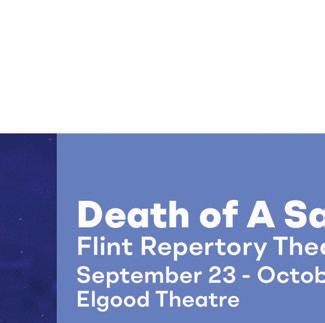






































































e summer wrapped up with some true Flint-style fun and world class events! I recently enjoyed another opportunity to participate in a unique event with my daughter Courtney – we went “Over the Edge” and rappelled down the face of e Durant (see p.76). We were joined by a group of other supporters who met the challenge to raise funds for e Disability Network (TDN). I can’t wait to do it again next year! Read more about the great work of TDN on the inside-front cover.
e Greater Flint community is not lacking for organizations that are dedicated to helping their fellow humans. Of course, you’ve heard of Whaley Children’s Center and the work they do. But what about President/CEO Mindy Williams? What’s her favorite family recipe? What makes her feel at peace? Find these answers and more on p.10-11.
Also pro led in this issue is John Henry, former director of the Flint Institute of Arts. Read about his journey to Flint and impressive contributions to growing the FIA during his 25-year tenure (p.12). We wish John and Janice all the best for a ful lling retirement.
Not planning to retire is a Montrose resident, amputee and captain of the U.S. ParaGolf team, Tracy Ramin. He’s on a mission to get adaptive golf into the Paralympics – great story! And, local science teacher Melissa Koronka was chosen to receive the Cranbrook Institute of Science 2022 Outstanding Educator Award – fantastic! (See p.16.)
ere’s much more: eats, fun, tech, music, style, history and art … this issue has something for everyone. While we get so much positive feedback about our publication, we’re always striving to make it better, more engaging, more interesting. We often wonder: what do you think of My City? On this page is a QR code that will take you to a quick survey; for your participation, we’re giving you three free issues of MCM (and our sincerest appreciation).
PUBLISHER & EDITOR IN CHIEF
Vince Lorraine
MANAGING EDITOR
Sherron Barden
ASSISTANT EDITOR / WRITER
Peter Hinterman
STAFF WRITER
Cheryl Dennison
FREELANCE WRITER
Mark Spezia
CONTRIBUTING WRITERS
Erin Caudell
Dr. Christopher Douglas
Vera Hogan
Joel P. Lagore CFP, AIF
Alexandria Nolan
Leslie Toldo
Shannon White
GRAPHIC DESIGNER
Hailey Worrell
WEB DEVELOPER / GRAPHIC DESIGNER
Jonathan Boedecker
PHOTOGRAPHY
Katy Kildee
Jaden Maxlow OPERATIONS
ACCOUNTING/CIRCULATION
Kim Davis
NEW BUSINESS DEVELOPMENT
Dan Garman
SALES
ACCOUNT EXECUTIVE
Terese Allen
I hope you had a wonderful summer ... it’s time for all the fun that fall brings – and My City will be there! anks for reading, 5152 COMMERCE RD. FLINT, MI 48507 810.230.1783 - MYCITYMAG.COM


&


ISSN#1559-3436 is published monthly by My City Magazine, Inc., 5152 Commerce Rd., Flint, MI 48507. Canadian Mail Agreement #41971515. For back issues, inquire for availability. Editorial Correspondence: Address product information and inquiries to: Editorial Department, My City Magazine, 5152 Commerce Rd., Flint, MI 48507, phone 810.230.1783. To authors, photographers, and people featured in this publication: All materials, articles, reports and photographs in this publication are the property of My City Magazine and cannot be used without written permission. e opinions and conclusions recited herein are those of the respective authors and not of My City Magazine. My City Magazine is not responsible for returning unsolicited manuscripts, photographs or other materials. Every e ort will be made however, to return rejected manuscripts, etc., if they are accompanied by su cient rst-class postage, but the publisher will not be responsible for any loss of such material.
Copyright© 2022. All rights reserved. | Printed in U.S.A.









































CEO, Whaley
COMPILED BY SHERRON BARDEN






1
When you were a kid, what did you want to be when you grew up? I wanted to be a nurse. During my rst semester in college, I volunteered at a health fair at a homeless outreach luncheon where my job was taking blood pressure. Midway through, my Iine of people was the longest which caught the supervisor’s attention and she asked why it was taking me so long. While taking their blood pressure, I found myself trying to help connect people to services that could assist with meeting their needs. It was on that day that she suggested I pursue social work – and I never looked back.
2
What movie can you practically quote from start to finish?
As a huge sports fan, the movie “Rudy” has always been a favorite – the real-life story of Daniel “Rudy” Ruettiger, who dreams of playing football at Notre Dame. “Rudy” convinces people that if you are willing to work hard for your dreams, you can accomplish anything. The story inspires you to continue pursuing your dreams even when you’re confronted with obstacles. We could all use a little “Rudy” in our lives.
4
What life achievement are you most proud of?
By far, raising my son has been my greatest achievement. He lost his father at a very young age, resulting in me being a young, single parent. With no script or parenting manual, there were so many times when I worried and hoped I was giving him the support and guidance he needed. And, as so many parents do, I often worried if I was making the right choices as a parent. I am so proud of the young man he has become and cherish our special relationship more than anything on Earth.
3
What is your favorite family recipe?
My dad’s chicken noodle soup is hands down the best ever! I have so many memories of him making it when I was a child. Over the years, when we are not feeling well or if he knows we’re having an extra busy week he has made it for all of us – my sister, brother, aunts and uncles, our friends … it’s a whole thing! I consider myself a pretty great cook, but I have never been able to exactly replicate it.
5
What are you most excited about in your life right now?
I’m taking some time to focus on myself. I’ve been in social work for nearly 20 years and it wasn’t until recently that I bought into the importance of self-care. Sometimes, we work so hard to care for others, we put off doing things for ourselves. With my son now pursuing his dreams and serving in the U.S. Army, I know that now is the time for me to focus not only on my self-care, but also to try some new things and perhaps start some new hobbies. I’m excited about what this chapter in my life will bring!
6
What is one work-related thing you want to accomplish in the next year?
I want to expand our Independent Living Program. Being a young adult is hard enough when you have the support of a family and social network; but being a young adult aging out of foster care can be absolutely overwhelming. The statistics give a grim outlook for most of these kids, and I am hopeful we can provide the missing support system that truly helps them get the foundation they need to successfully transition to adulthood. I am so excited to see the outcomes I know these young adults can achieve if only given the tools and support needed.
7
For me, it’s a sound. At the end of a busy day that may include anything from budget meetings, event planning, contract negotiations, addressing employee concerns and any other number of required tasks – to step out of my office and hear the sound of my Whaley kids laughing outside at the Center brings me such joy and peace. In that moment, I know we are accomplishing our primary goal and that our kids are truly getting to just be kids again.



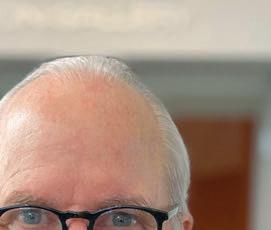









BY PETER HINTERMAN PHOTOS PROVIDED BY JOHN HENRY
After 25 years of dedicated service to the community as director of the Flint Institute of Arts (FIA), John Henry is ready for his life’s next challenge: retirement. “I’m 73,” he says. “I still have plenty I want to do and see and I feel that in ten years, those things may be a little harder for me to do. Secondly, the art world is changing in so many ways. I felt that it was time to step aside and bring in new ideas.” Since 1996, Henry has been the guiding force behind the resurgence and glowing reputation of one of the best art museums and schools in the United States. His adoption of and belief in Flint and his love for FIA are evident in his smile and passionate words as he speaks of his tenure here and his successful career in the arts.

A self-described military brat, Henry moved about the country with his family as a child but always nurtured an interest in art. “It goes back as far as I can remember,” he shares. “I always intended to become an artist.” His pursuit began at the University of South Carolina where he earned a degree in studio arts (sculpture), then went on to Auburn University for post-graduate work and nally settled at the University of Mississippi, where he earned his master’s degree in art history. With a recommendation from a friend, Henry became a curator at the Columbus (Georgia) Museum of Art. “ at’s how I got started in the museum eld,” he says. After six years, he headed back to Mississippi to join the planning sta for the new Mississippi Museum of Art and was then hired to plan and build the Vero Beach Museum of Art in Florida, where he soon became director. “It was there that I met Marylin Truesdell, a
trustee on the board of the Flint Institute of Arts. She invited me to Flint to tour the museum and school and consider the director’s position. When my wife Janice and I arrived, we were pleasantly surprised by Flint and I was intrigued by the FIA, its large school, outstanding collection, and its location within the Flint Cultural Center.” What also stood out to Henry about the museum was its stellar national reputation and support from the local community. “From what I could see, it was poised to regain its identity as an essential destination.” Henry took the job.


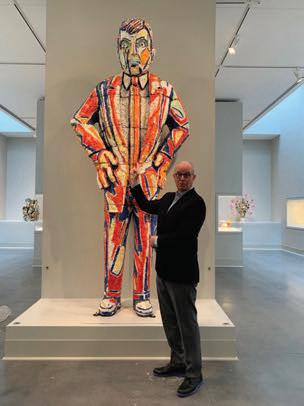



When he arrived and assessed the situation more thoroughly, signi cant challenges made themselves apparent. For one, the building, built in 1958, needed important and costly upgrades; the school’s studios needed to be brought up to 21st century standards (including the installation of air conditioning and new windows); gaps in the collections needed to be lled and exhibitions, education programs, community outreach and fundraising e orts all needed a jump-start. “Another thing of greatest concern to me,” explains Henry, “was the fact that the building was under lease from the Flint School Board and many of our most important art works, including the entire tapestry collection, were under their ownership. Transferring title to the collection was my rst order of business.” Indeed, as soon as the opportunity presented itself to take sole ownership of the museum’s collection, Henry jumped into action, putting the collection in the museum’s hands, then and for the future. He also put monumental e ort into expanding the museum’s physical footprint to better present the FIA’s expansive collection and better establish and equip its art school. “I believe the FIA now has either the second or third largest art museum school in the country,” he says with pride.
During Henry’s tenure as director, three new wings were added to the facility bringing the total to 19 galleries, three additions to the art school resulting in 15 studios and 5,000 new works of art. With an endowment valued at around $40 million, no debt, hundreds of dedicated volunteers and the most capable professional sta he has ever worked with, Henry believes the FIA is set up for a phenomenal future. “ e main thing is to keep moving forward,” he explains. “It shouldn’t be too di cult to stay on an even keel; however, there will be great challenges ahead. e arts are fragile (more now than ever) and need all the support they can get. We cannot simply take it for granted that the FIA will always be what it is today. at would be a mistake.”
To Henry, Flint’s art and culture are the city’s new backbone and should be more readily embraced by all, including Flint’s leadership. “ e arts make a community a more desirable place to live and visit,” he explains. “Institutions like the FIA, FIM and Sloan are re ections of who we are and what we think is important. Our institutions are essential to Flint’s growth and
“My retirement is the end of the chapter for me, but not for the FIA. The FIA’s story has many more chapters yet to be written.”
JOHN AND JANICE HENRY HAVE TRAVELED THE WORLD IN A LIFE DEDICATED TO THE ARTS.
BELOW(L-R) THE HENRY FAMILY INCLUDES JOHN, GRANDDAUGHTER ALEX, JANICE, DAUGHTER MEGAN HENRY ROLF, GRANDDAUGHTER GABBY, SON-INLAW JEFF ROLF, AND SON JACK.









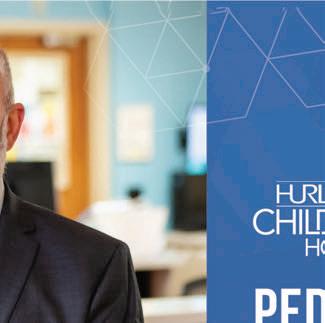

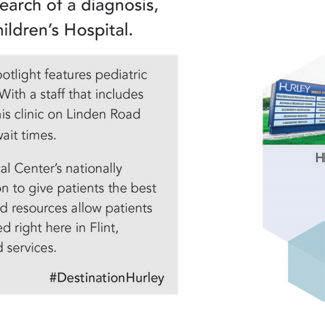




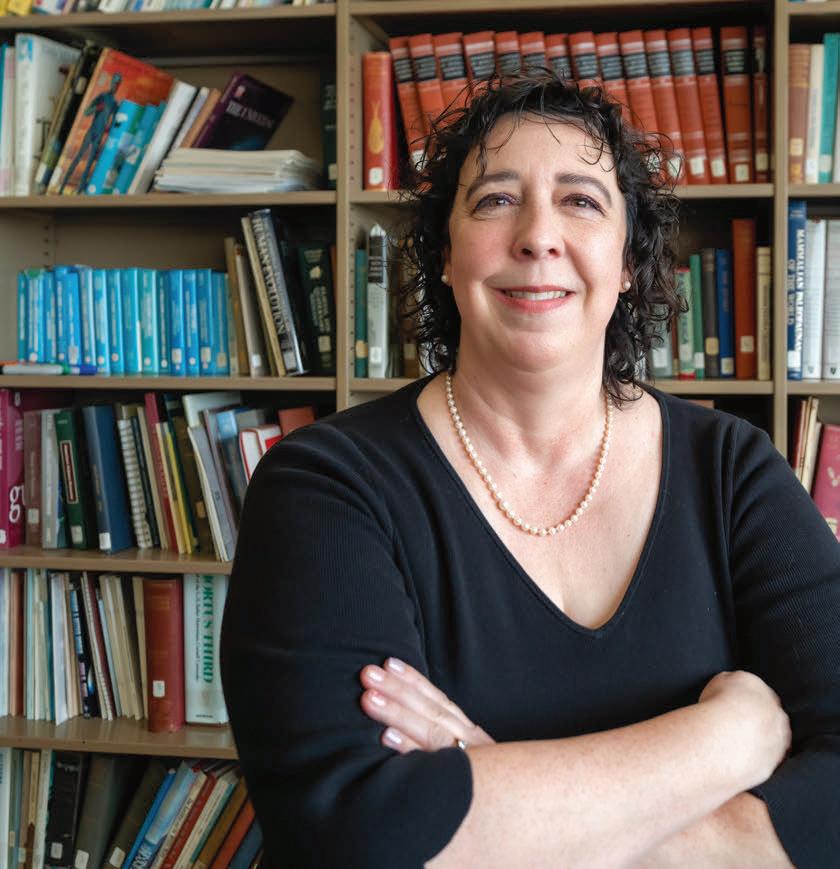

BY CHERYL DENNISON
Melissa Koronka, a science teacher at the Accelerated Learning Academy (ALA) in Flint, was chosen to receive the Cranbrook Institute of Science 2022 Outstanding Educator Award. Every year, Cranbrook hosts the“Women Rock Science” gala, which recognizes three individuals who are making a difference in the fields of Science, Technology, Engineering, Arts and Mathematics (STEAM). The award recipients will be recognized at the fifth annual gala held on October 12 in Bloomfield Hills.
The ALA is an alternative high school in the Flint Community School system (FCS). With a student population of 150 and eight teachers, the academy offers alternative learning for students in grades 9-12 who have not been successful in other classroom settings. “I really love working with the alternative students!” Koronka exclaims. She has been a science teacher for FCS for 26 years. About 11 years ago, Koronka began chaperoning the Flint students who were selected to participate in the internship program offered by Cranbrook. Her position at Cranbrook evolved and she took a leadership role in designing a virtual program for the school.
“I see students thrive after watching them struggle - that is amazing to me. That is what makes my job worthwhile.”
Although the selection process for the Outstanding Educator Award is unknown to her, Koronka does know that she loves teaching. “The students in my class are amazing,” she shares. One of her students, a former Cranbrook intern, graduated from Michigan State University and became a veterinarian. “My greatest joy is seeing students believe in themselves, reach their goals and become successful,” says the science teacher.
Many ALA students have suffered some sort of social or emotional trauma and it is important to Koronka to cultivate a climate that isn’t overwhelming. The school is dedicated to providing the students with a safe space to learn, and ensuring that they have access to the resources they need. The school day begins with the playing of soft music and the students practice a mindfulness exercise. “The brain needs a break,” Koronka explains, adding that the exercise actually helps to promote learning.
ALA students often have trust issues and Koronka strives to promote a place where they feel welcome. And the students help promote that climate, she notes. The number of fights has dropped significantly. If a student is having a bad day, there is a social worker on staff who talks to them and helps them resolve their issues.
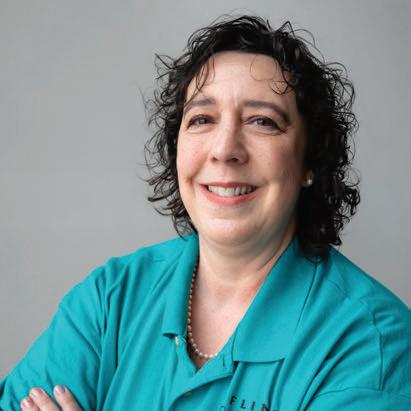

KORONKA WITH STUDENTS IN HER CLASSROOM AT ACCELERATED LEARNING ACADEMY ▶

Koronka was very surprised when she was notified that she was selected to receive of this year’s Outstanding Educator Award. “I’m pleased and very honored,” she says. But what’s most important to her is the role she plays in her students’ lives. “I see them thrive after watching them struggle – that is amazing to me. That is what makes my job worthwhile.”














BY CHERYL DENNISON
PHOTOS COURTESY OF BUCKHAM GALLERY
For local artist Janice McCoy, making art is as necessary and natural as breathing or drinking water. She loves to draw and paint but works primarily in linoleum printmaking. “I’ve loved making things since early in my childhood,” she shares. Her fondest memories are of drawing in kindergarten and di erent elementary school art class projects. She also took art classes in middle school and high school but was never really encouraged to look at art as a viable career option.
Linoleum printing (or linocut) is a relief printmaking technique in which you plan and carve out an image, McCoy explains. “ e ink is then rolled onto that carving and you can then create multiple impressions of that image. It’s like a large stamp.” Because
she was in the education program in college, she had to learn how to work with many di erent art mediums. “After taking a printmaking course, I was hooked,” she says. “I still love painting, but printmaking is just such a cool process. I love the idea of multiples and the potential for experimentation with ink, papers and layers.” McCoy grew up in the small town of Leonard in northern Oakland County. She moved to Flint to attend the University of Michigan-Flint and graduated in 2018. “I originally went to college to study biology,” she shares. But after taking a ne art class, she decided to pursue an art minor, which turned into two art degrees and a minor in art history. “Making art has always been a

“I believe art is a way to work through and process your experiences and share them with the world, if you choose.”
major part of my identity,” she says, “and it was life-changing when I finally acknowledged and embraced that. It’s hard to imagine my life without art.”
One attractive aspect of printmaking as an art medium is its affordability. “You can sell prints at a much lower price point than paintings,” she shares, adding that much of the history of printmaking is based around the idea that art should be affordable for everyone, not just wealthy people. Printmaking has also had a considerable role in spreading ideas related to social justice and equality.
Much of McCoy’s art builds on natural elements, flora and fauna, which she uses as visual symbols to communic ate ideas related to her life and her experiences. “I try to create broad and open narratives, some of which can be a little odd or disturbing to look at,” she states, “but ultimately, I want to capture the viewer’s attention and make them think a little and hopefully find some common ground to identify with what I’ve created.”
McCoy is still working on figuring out what she

wants to express through her artwork. “It can be terrifying to admit that you have uncertainty concerning the way you’re going,” she admits. “But it’s also been very liberating because I have had the opportunity to try different things, really dig in deep to learn about artists I like and become more heavily involved with Flint’s artistic community. It’s been a rich experience that I know will serve me going forward.”
Enjoying a career born of her love for art, McCoy is the gallery assistant and programs coordinator at the Mott Warsh Gallery in Downtown Flint. She is also vice president of the board of directors at Buckham Gallery/Buckham Fine Arts Project. In addition, she teaches occasionally at the Art School at the Flint Institute of Arts. The artist has shown her work around the state, including Pontiac and Detroit, and her art is regularly on display at Buckham Gallery.
“For a city of its size, Flint has so many places to view great works of art and be involved in making or learning about art,” McCoy notes. “If you are an
artist or if you just have an interest in art, I encourage and challenge you to seek out all of the art institutions in your community and support them and become more involved. You’ll learn some cool stuff, you’ll see unexpected things, and you’ll meet some interesting people.”
What does art mean to McCoy? “I think that at our core, we are all naturally creative beings,” she says. “I believe art is a way to work through and process your experiences and share them with the world, if you choose.”
To learn more about relief printmaking, McCoy is teaching a class at FIA on Wednesday nights from 6-9pm, September 7 through November 9. To register, visit flintarts.org/ learn/news.
Through September 17, McCoy’s work is on view at Buckham Gallery along with many other local artists for the exhibit entitled, “CAUTION: May Contain Nudity. Recent Works by Donovan Entrekin & Friends.” For more information, visit buckhamgallery. org. You can follow her on Instagram @janiceemccoy.
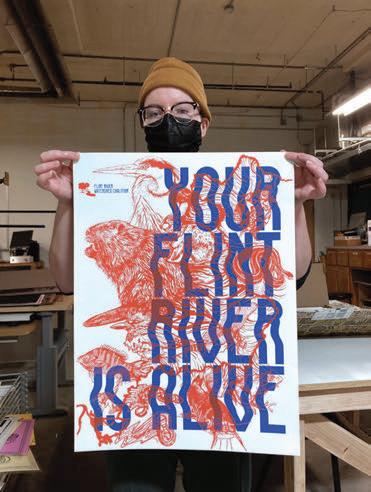
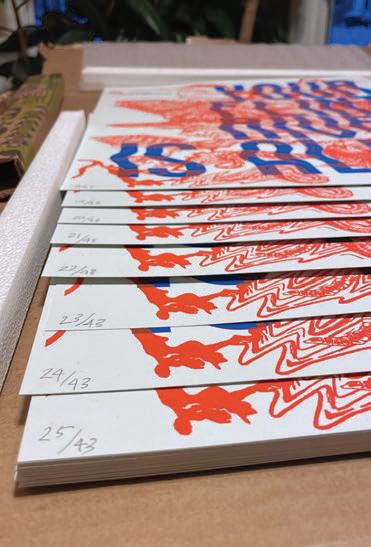

BY PETER HINTERMAN PHOTOGRAPHY BY JADEN MAXLOW
“Are you happy here?
Fernando Silverio Solis asks this question of his audience and most importantly, himself, in an original song that more than any other expresses his perception at this point of his life. After decades on tour performing for thousands of fans in musical genres that never quite felt like his own, the singer/songwriter has nally found his inner voice and a new way to express it; a style he found long ago but never had the time or the con dence to try. “I always dreamed of becoming a singer/songwriter,” says Solis. “I was fascinated by the sort of ‘blue-collar’ songwriters like Bruce Springsteen, Neil Young and Billy Joel. It feels good now to do it myself.” Today, Solis describes his music genre as “Americana; a portrait of the working class in the United States – of love and loss,” and it’s something very di erent for his past fans and a far cry from the music of his beginning … Solis grew up in Flint and attended Flint Central High. “I was born in Fairfax, VA but it’s just where I was born, not where I’m from,” he states. “I’m from Flint and that’s something I’m proud of.” As a child, he was interested in music but it wasn’t until middle school when his love a air with it began. “I really got into punk and nu metal – bands like Korn and the Deftones,” he remembers. His love continued into his high school years when the relationship started to become serious. “A friend took me to Flint Local 432
for the first time and I was blown away,” he shares. “The energy was incredible and being there, I felt like I was really a part of something. Everyone was so welcoming. The show featured a lot of punk and ska bands and one had a bassist who was having the time of his life. He looked so cool. From then on, I wanted to play the bass. I was hooked.” Solis, who was beginning to learn acoustic guitar at the time, immediately put it down and asked his parents for a bass and, although they didn’t understand why, they indulged him. “They got me a black Squier brand bass that I still have somewhere, all beat up,” he laughs. From then on, Solis made it a point to attend as many shows at the Flint Local as possible and even began volunteering there. Through a magnificent loophole, he was able to use his time working at the Flint Local to meet the community service requirements for the National Honor Society in school. “I still can’t believe that worked,” he says with a chuckle.
Working at The Local and meeting other musicians gave him confidence and soon enough, he was in a band of his own: Offing Ingus. They played nu metal and high-energy shows and enjoyed a small amount of local popularity. “While growing up, I always felt apart from other people in a way,” Solis remarks. “Being in that first band made me feel valued and connected.” He finally became devoted to music full-time and he dedicated the majority of his time to the wild thrash scene. “I loved everything about it,” he adds. Still, something was missing. “I was having fun but the music we were making didn’t sound like me,” he explains. “There was something about myself that wasn’t being explored.” When Offing Ingus began to dissolve, a friend introduced Solis to a band called Bright Eyes. “It was exactly what I needed at the time,” he explains. “It was a different type of music that showed it was okay to explore mood and emotions and following that, I picked up my acoustic guitar for the second time.” He just as quickly dropped it again when he and friends formed the indie-rock band Remember Me, and Solis tried his hand at writing
lyrics for the first time. “They were the worst,” he admits. Next, came the band The Transatlantic Sail and its offshoot, I Am the Sky. “With those early bands, I had no idea of monetary success. We didn’t care about money at the time. We were so naïve – we thought success would just magically happen,” he states. After high school graduation, his parents began to question the path he was on and wondered about his future. Solis was beginning to wonder, himself. “I had no idea what I wanted to do or where I was going,” he says. “I went to college for a little while but that didn’t last long. So, I decided it was time to get serious about music.” With friends, he formed nu metal band 1876 and began to set immediate goals. He and his bandmates thought they had it all figured out; they had a plan and felt as if stardom was inevitable. It was during this time that Solis got married and had a daughter. “I had a family and I was working a job while traveling with the band,” he states. “We were doing well and filling venues, or so we thought. It still wasn’t working and we kept pushing back our goals. We were getting frustrated.” Solis soon realized that his time with the band was a strain on his marriage and made the tough choice to step away. “I told the guys that I had important things to attend to at home and couldn’t go on. I felt like I was letting them down.” Although his marriage would eventually end, Solis cherishes the time he spent with his wife and still maintains an amicable relationship. “She loved the Beatles and I heard them nearly every day. I started to listen to how they wrote music,” he says. While separated from 1876, Solis finally found the time and place to write the kind of music he needed to. “The whole time, through all the early chaos, I was learning to be a musician but I wasn’t learning to be the singer/songwriter I always wanted to be,” he says. He picked up his acoustic guitar for the third time, dusted off an old MacBook given to him by his uncle for college, and began to write and record music that was closer to his heart. He released a collection of songs under his full name and complete with music video.

“I make my music and I’m creative and expect nothing in return. Whatever happens is cool with me.”
“I shot and scored a short film called ‘Memories’ with a friend and we were able to show it to a live audience,” he adds. Solis had taken his long awaited first steps. His world was quieting down and he began to listen to his inner self and show vulnerability in his music.
Solis took one more chance with 1876 and played some big shows but the band self-destructed, essentially tying off one more loose end and allowing him to go into his singer/songwriter career – leaving metal behind, with no regrets. “Things were becoming more important,” he explains. “I couldn’t use the music to support my daughter and I was finally beginning to understand. We had been too impatient. As a musician, I have realized that patience is important. I was making music, continuing to be creative and putting it out there … and people were responding.” Solis jumped into Americana and played and wrote for a band called Goldblum for a little while, which ended around 2018. “I held some songs back for myself and as Goldblum was ending, I recorded them with veteran musician Nick Diener (The Swellers) at his studio. During the pandemic, I released a four-song EP and never looked back.”
Through all of the ups and downs, failures and success, Solis wouldn’t change a single step of his journey. He has learned about patience, confidence, humility, understanding and most importantly, himself. He remarried in 2019 and now spends his days being of service to people in his full-time job. His recent music is some of the most heartfelt, melodic and relatable of his career and has brought him more success than he dreamed. Every positive word he hears and every show he plays is a gratifying surprise. “I feel like I am finally starting,” he smiles. “I have a whole new perspective and I am grateful for what I still get to do musically.

“ ”
After all of it, it’s the tenacity that comes from being a part of Flint that has helped me continue creating. It’s a part of everyone here. It’s in our blood.


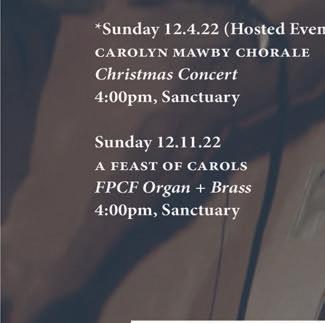
















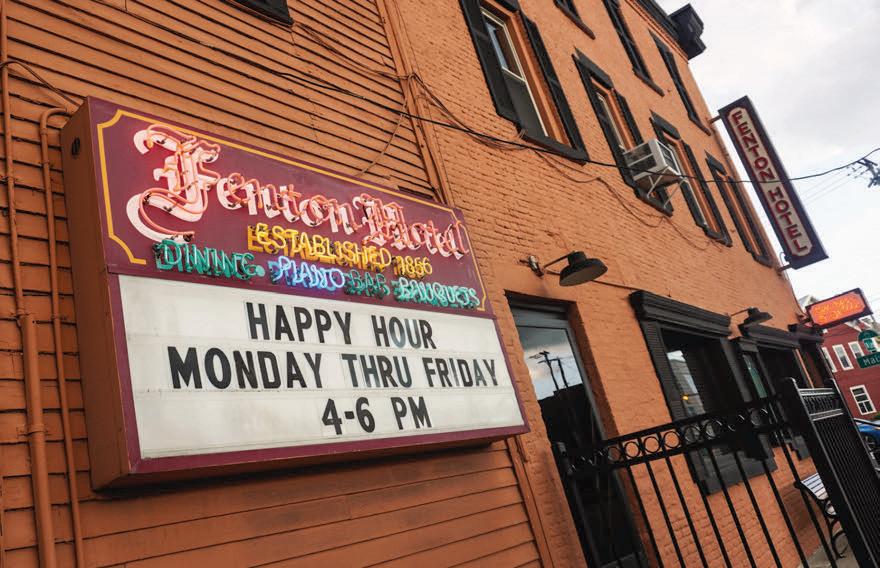









BY CHERYL DENNISON PHOTOS COURTESY OF JINX’D PHOTOGRAPHY

Forthe past 25 years, Nick and Peggy Sorise have been proud owners of the Fenton Hotel Tavern & Grille. Formerly named the Fenton Hotel, it was rst built when the railroads came to Fenton



in 1856. e couple purchased it in 1997 and looking back over the last 25 years, they have seen many changes. Today, they strive to keep the popular dining institution relevant for its customers.




















“In 2006, we re-named the restaurant and remodeled,” Nick Sorise shares. “We wanted it to have a more casual feel. Fenton has changed tremendously over the past 25 years and we wanted to meet the needs of our customers.”
Gone are the white linen tablecloths, he points out, and the formal dining room and menu o erings are more casual.
e addition of the very popular outdoor patio at the Fenton Tavern & Grille occurred in 2016, which created seating for 40 guests.
Other recent updates inside include new planked



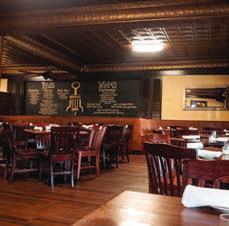
ooring in the grill room and the private room.
Sorise admits to going through some challenging times over the years. On Easter Sunday in 2017, a re tore through the kitchen causing extensive damage. ey reopened in September 2017. e shutdown during the pandemic was another challenge, as it was for most businesses.
Rising costs and supply issues have been a more recent problem.

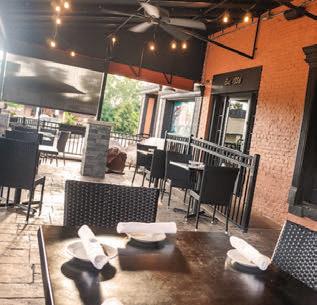


What the restaurant is known for is the delicious food. Gradual changes



have been made to the menu, including the addition of three more salads. ere are also two new potato side dishes, including the yummy Hotel au gratin potatoes with jalapeno.
Customers can enjoy a variety of fresh sh on the menu prepared six di erent ways – sautéed, charbroiled, blackened, cedar planked, pecan-crusted or broiled. “Fresh sh is the heart of our menu,” says Sorise. “Our motto is ‘serve


fresh food’. When it’s gone, it’s gone.”
A longtime favorite that has remained on the menu are the fried frog legs, which are served allyou-can-eat on Wednesdays and made from a secret recipe. Other classic favorites include Oysters Rockefeller and baked escargot. “We give our patrons a lot of choices,” states the owner. “Our most popular entree is the lake perch. People just love our lake perch!” Diners also enjoy the rich and creamy shell sh bisque made with lobster, crab and clams.



BY ERIN CAUDELL
I don’t know how I made it this far in life without knowing what a Dutch Baby is. I’ve certainly never heard it called a “hootenanny” until I checked for some history about it while writing this column. But whether you know it as a German pancake or either of the above monikers, you need to make one – because it’s just delightful!
Essentially a bigger version of a popover, the Dutch Baby can be made sweet or savory. As it bakes, the sides rise above the edges of the skillet to create a golden, pu y crust with a tender, eggy middle. And since it’s cooked in the oven, there’s no standing over a hot stove while you make a bunch of them for everyone else and then get to eat cold pancakes.
Why have I fallen in love with this oddlynamed dish? Its custardy center and crispy edges are amazing and delectable. It’s guaranteed to be impressive when you set it on the table, yet so simple to make.

Erin Caudell is co-owner of The Local Grocer, a horticulturalist, herbalist and farmer.
(sweet version)
• 6 large eggs, room temperature
• 1 cup milk, room temperature
• 1 cup all-purpose our
• 5 tablespoons butter
• 1/2 teaspoon vanilla extract
• 1/4 teaspoon ground cinnamon
*FOR A SAVORY PANCAKE, ADD A HALF TEASPOON OF SALT AND SUBSTITUTE YOUR FAVORITE HERBS (SUCH AS THYME OR BASIL) AND/OR GRATED PARMESAN CHEESE FOR THE VANILLA EXTRACT AND CINNAMON.
Sweet
• Fresh fruit
• Maple syrup
• Jam
• Whipped cream
• Chocolate shavings
Savory
• Runny egg
• Bacon crumbles
• Roasted tomatoes
• Pickled onions
• Feta cheese
While preheating to 450°F, warm a cast iron skillet in the center of the oven. Break the eggs into a bowl and whisk until frothy. Add the rest of the ingredients and whisk for ve more minutes. When hot, carefully bring the skillet out of the oven and drop in the butter. When butter is melted, immediately pour the batter in and return the skillet to the oven for 20-25 minutes until the pancake is pu y and golden brown. (DO NOT open the oven during the rst 15 minutes of cooking or you might de ate your pancake!) When you remove it from the oven, the pu will de ate and leave a “well” to put your toppings directly into, or you can cut individual slices for everyone to top on their own.
Whether you go with a lemon-blueberry flavoring for breakfast or choose a savory combination for dinner (see ingredients*), it is best served straight from the oven. The golden puffiness quickly deflates … so have your forks ready to dig in!











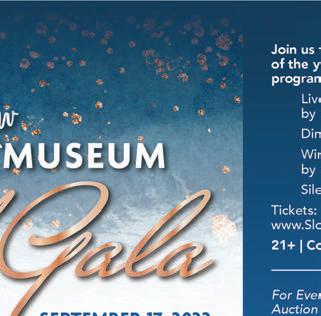



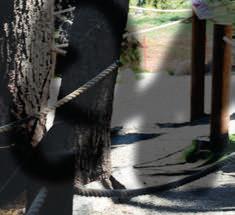

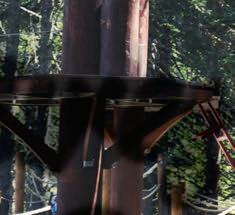



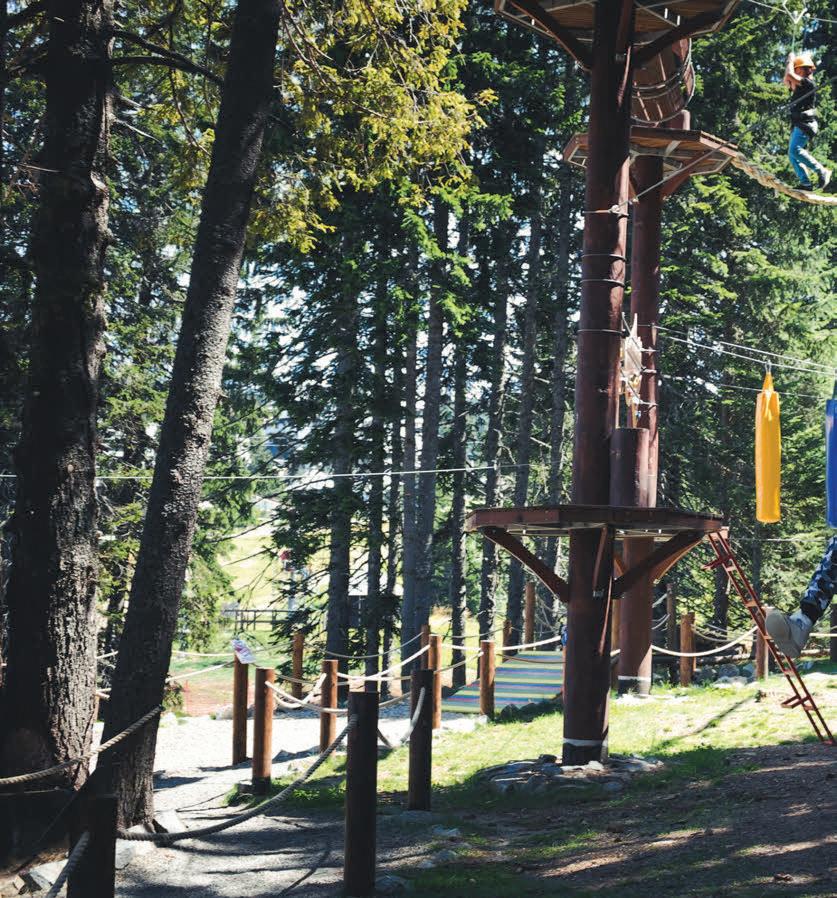



BY PETER HINTERMAN
Just because summer is coming to an end doesn’t mean the fun has to. Why not get the kids away from the screen for a few hours/ days or grab a bunch of friends and try something new? Everyone dreams of being able to climb tall buildings or soar through the air and at a few locations in Michigan, you can do it. Rock climbing and zipline adventures can be an adrenaline-pumping, healthy and wholesome time and with luck, you will be discovering new habits and passions that will keep you (and your children or friends) occupied into and throughout adulthood. (Please call locations for reservations, rules and age limits.)






5081 Torrey Rd., Flint
810.591.4622
A part of the Genesee Career Institute, this is the place to go for team-building. It features a high-ropes course, 30-foot rock wall, and challenge structure complete with a cable walk, zipline and ladder climb.
e Challenge Center is open for a group of friends, families, sports teams, non-pro t and corporate groups. Call and schedule your team-building experience!
777 Boyd Ave., Traverse City
231.600.7260
Going “up north” on vacation and want to elevate your experience? Check out this rock gym and fitness center offering varied terrain and different climbing styles at heights from 14 to 40+ feet. Rental gear is available. All new and seasoned climbers must take a skill assessment test before climbing and classes are available.
639 76th St. SW., Byron Center
616.281.7088
e rst climbing gym in Michigan, Inside Moves
o ers top-rope and lead-climbing on walls up to 34’ as well as a large bouldering area that will challenge beginners and seasoned veterans alike. Before climbing, all new visitors must pass a check or partake in beginner lessons. Rental equipment is available, as well as an a ordable “1st Time Package.”
700 W. Front St., Grand Ledge
517.627.2149
You’ve conquered the gyms, now it’s time for the real thing – natural rock formations on which to test your skills. e ledges in Oak Park are NOT a place for a beginner climber unless they are a part of a group receiving “how to” instruction. More than 80 climbing routes have been identi ed, named and rated according to di culty. Climbers must follow the posted Code of Ethics and Guidelines for Rock Climbing to ensure safety and nature preservation. Again, Oak Park is for seasoned climbers.
82 Aprill Dr. C., Ann Arbor
734.827.2680
1103 W. 13 Mile Rd., Madison Heights
248.397.8354
ink you have what it takes to scale a 50-foot sheer cli ? Find out at Planet Rock! is climbing gym is for enthusiasts and beginners alike. ere is something for everyone including chimneys, boulder routes, stalactites, caves and more. Safety is a priority and every new member must either take a Starter Lesson or pass a belay check. If you wish to do more than climb, each Planet Rock facility also boasts a full tness center with showers.



Riverfront Plaza, Allegan
269.430.3961
Experience a 600-foot-long zip across the Kalamazoo River with family and friends in Allegan. Relax for a few on the other side and get ready for your return trip. After the zipline ride, stay for more fun including the Clip ‘n Climb, the sky trail indoor rope course, vertical drop slide, arcade and outdoor maze. It’s a fun time for all ages!
1375 Weiss St., Frankenmuth
989.284.0201
is facility provides a combination ropes course and zipline for group or individual entertainment. Choose from six di erent courses at various skill levels, each o ering a new experience. Make sure to take the fan-favorite FrankenZip course with seven lines at heights ranging from 15-35 feet o the ground. Reservations are recommended.
1005 Triangle Lake Rd., Howell
517.546.0249
O ering much more than beautiful scenery and nature trails, the Howell Nature Center is an education-based family/group experience with plenty to do. Explore the Wild Wonders Wildlife Park Teaching Zoo, run wild in Alexandria’s NatureScape and e Tree House, and don’t forget to experience the Glacier Valley Zipline Tour. Lodges are available for overnight stays.
3100 Holiday Rd., Traverse City
231.938.2500

Just a little jog north, you’ll nd “Michigan’s most beautiful zipline tour.” is high-speed zipline adventure will let you experience gorgeous, scenic views of Northern Michigan at speeds up to 30 mph! e hourlong tour takes you through the trees and across the hills of Mt. Holiday. A Hike & Zip Adventure is also o ered for those short on time. Reservations are required.
7553 Meadow Brook Rd., Rochester 6200 Drake Rd., West Bloom eld Township 2121 Celebration Dr. NE, Grand Rapids
248.759.5222
“Try something new and live your life adventurously!” is the tagline of the TreeRunner Adventure Park at Oakland University. is park boasts over 75 obstacles and ziplines, four di culty levels and eight di erent courses to take. Obstacles include cargo nets, barrels, bridges, ropes and platforms. As a bonus attraction, the park features Halloween Glow Nights from September 30 - October 31. Reservations are required for all adventures.













BY SHANNON WHITE PHOTOS PROVIDED BY SHIFT
It’s never too early to start thinking about fall fashion, which is arguably the best time of the year for dressing. It’s cold enough to wear all of your fave pieces at the same time (helloooo, layers!), but warm enough to actually go out and about to show o your t. Exciting, right? So, why wait?! Plus, with so many clutch deals and stylish nds available in











stores, now’s the time to get a head start on fall clothing and accessory shopping.
One fall essential is a u y, cozy wrap. Check out the Katydid Camo Wrap – the camo trend is still going strong and a wrap like this is perfect for sitting around a re or in the stands at a Friday night football game. Cozy and cute? Check and check! A great vest is also






one of the best outerwear options for the in-between weather of fall. e Anorak Midi Vest is a sta favorite at SHIFT. e extra length means extra cozy!
And although we hate to put our toes away til next summer, wearing some stylin’ new kicks will make it more appealing. A pair of leopard-print slip-ons are perfect to wear with your jeans – neutral, yet fun. Or try a pair of sneakers embellished with sparkles and stars, like the Pamela Sneaker by ShuShop. You won’t miss those sandals at all!
e transitional nature of fall means you need a great transitional dress! Although layering a sweater or jacket over your favorite sundress can certainly work, why not try a beautiful fall style like the Sugarlips Double Take Ru e-Hem Dress? e long sleeves are more appropriate for fall, but the short, ru ed hemline is still a super-fun look on a warmer fall night.
So, as you prepare to cover up for the fall season, look for everything from matching sets (cozywear pants and tops) and faux leather leggings and jackets





(especially motorcycle style) to boots, blazers, jackets and coats – these are the killer fall fashion items to add to your cart ASAP. Straight-leg jeans with distressed whiskering and a variety of hemlines are back! Florals continue in breezy tops with structure but a feminine hint of ru e at the cu and shoulder. Pu -sleeved sweaters and those with gorgeous embroidered detailing rock! And we’re not just talking everyday basic fashion, either – at SHIFT in Downtown Flint, we’ve got plenty of on-trend clothes and accessories from the great a ordable brands and luxury designers you love.

Shannon White is an architect, designer and fashionista – a small but mighty cheerleader of all things Flint! Holding both Bachelor of Science and Master of Architecture degrees from the University of Michigan, she is the founder of the FUNchitecture design firm and co-founder of she-powered Downtown Flint retail business, SHIFT.
BY MARK SPEZIA PHOTOS PROVIDED BY MIDWESTERN AMPUTEE GOLF ASSOCIATION
Every so often, a poignant moment or life milestone reminds Tracy Ramin of how fortunate he is or the reasons why he is still alive and thriving 24 years after losing part of his left leg and very nearly his life in a horrific accident.
The Montrose resident was struck by a speeding pickup while attempting to retrieve a ladder that had fallen from his construction truck onto I-75.
Now 50, Ramin has seen his two children, one of whom was born after the accident, grow into adulthood, held his first grandchild and refused to let having to wear a prosthetic limb prevent him from enjoying two of his favorite sports.
The 6-foot-3 Ramin, who played varsity basketball for Mount Morris High School, continued taking to the court for competitive games until about ten years ago. His greatest sporting passion, however, is golf. Ramin’s love for the game grew after first playing it with his father at age 13. They later won a league title together.
Returning to the course a mere three months after leaving the hospital, Ramin began adjusting to his new normal and was playing in adaptive golf events less than two years later, gradually rising to a place among the top ten Americans in the World Rankings for Golfers with Disabilities (WR4GD).
This ignited a burning desire within him to help those with physical or mental disabilities to still enjoy the sport and expand competitive opportunities for them.
Thus far, the most significant result of the tireless efforts of Ramin and others was the first U.S. Adaptive Golf Open, held in July at iconic Pinehurst Golf Resort in North Carolina,the site of three U.S. Opens.
From an initial pool of 300 applicants, Ramin was the only player among the 96 selected for the historic event asked to speak at a pre-tournament banquet. He could not help but become emotional after being introduced by United

States Golf Association Director of Communications, Beth Major.
“It’s so great to see everybody here,” Ramin told the crowd of more than 300 before thanking the USGA and revealing some unforeseen positive aspects of being an amputee. “I used to have to put both shoes on every time and now one of my shoes is already on, so I’m a step ahead. Also, I never had any friends outside of the United States before the accident and now, I have made friends in almost 60 countries.”
As a founder of the U.S. Adaptive Golf Alliance, a group aligned with 42 regional organizations and Executive Director of The National Amputee Golf Association, Ramin had been lobbying the USGA to create a U.S. Adaptive Open for years.
A turning point came when Beth Major attended the 2018 National Amputee and Disabled Championship at The Fortress in Frankenmuth, which Ramin helped organize and played in.
“The Adaptive Golf Alliance bringing so many adaptive golf organizations gave us a loud voice and Beth loved our tournament which led to positive conversations,” Ramin recalls. “A few months later, I was on a phone call with about 12 people from the USGA talking about how we can make a U.S. Adaptive Open happen.”
Years of planning followed before the first U.S. Adaptive Open was finally announced last December. Ramin was elated.
“Yeah, it was an incredible moment because adaptive golfers now had a major championship,” he says. “I was so happy for all the players who were going to benefit.”
Ramin applied for entry into the tournament in February, but preparing for it was going to require some work. He began sharpening his game which had taken a hit last year after he began a new job running a business which places massage chairs in malls.
“I felt I was going to get into the tournament because I had done so much to set it up, but was a little worried about how I might do because I had not been able to play as much golf and my handicap slipped to a three,” he says.
Soon, Ramin’s handicap began to improve, which was important because another major competition was looming sooner.
Ramin was named captain of Team USA for the Cairns Cup which pits adaptive golfers from the United States against a European team in a Ryder Cup-style series of matches. He led a 21-2 Team USA trouncing at The Shire Golf Club in London May 7-13. He returned home after celebrating with teammates and taking a drink from the Cup.
Just five days following that celebration, Ramin was officially notified that he made the U.S. Adaptive Open field. By the opening round on July 18, Ramin had whittled his handicap to about 1.7. He also takes pride in shooting scores in the 70s for 18 holes more regularly than before the accident.
Unfortunately, Ramin struggled to a 94 in the first round before rebounding for an 81 in round two and finishing with an 89. His 264 final score left Ramin tied for 51st in a field of 78 male entrants.
“I was hitting the ball well, but had trouble whenever it wound up in the sand,” he shares. “I struggled to find the best way to get the ball out of it which probably cost me 20 shots or more. I had a bunch of silly bogeys and took a nine on one hole, but the overall experience at Pinehurst was phenomenal.”
Ramin followed that experience by winning his sixth Michigan Adaptive Golf Championship, shooting 151 (77-74) for 36 holes less than a week later at Pine View Golf Course in Three Rivers.
It’s difficult to imagine how Ramin’s commitment to furthering adaptive golf could be any better.
In addition to his U.S. Adaptive Golf Alliance and National Amputee Golf Association duties, he is a Michigan Amputee Golf Association board member, helps oversee WR4GD rankings and conducts

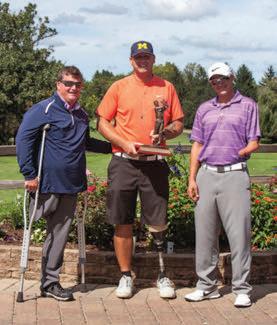

TRACY RAMIN HAS WON MORE THAN A DOZEN TOURNAMENTS, MOST RECENTLY THE CAIRNS CUP WITH TEAM USA IN LONDON AND HIS SIXTH MICHIGAN ADAPTIVE GOLF CHAMPIONSHIP.


“As an ambassador within the adaptive golf community, Tracy is working hard to improve events and participation on a global scale.”

clinics for disabled and special needs golfers around the country, including working with Shriners kids during the annual Shriners PGA Tour event in Las Vegas.
“ ings I’ve been privileged to take part in, like a clinic in Houston for 200 kids missing both arms, are so important to show people who are disabled in any way that they can get out and play golf,” says Ramin, who was scheduled to lead a clinic for adaptive golfers during last month’s Ally Challenge at Warwick Hills. “You never know who you are going to inspire. “
BRADLEY

SCHUBERT PRESIDENT, MIDWESTERN AMPUTEE GOLF ASSOCIATION

PHOTO CREDIT: UNITED STATES GOLF ASSOCIATION


PHOTO CREDIT: MICHIGAN AMPUTEE GOLF ASSOCIATION
Ramin’s loaded schedule also includes serving as a teaching professional at Briar Ridge Golf Course in Montrose. He provides roughly four lessons per week to golfers of all ages and ability levels. Last year, his students ranged from a three-year-old boy to a 92-year-old man.
“As an ambassador within the adaptive golf community, Tracy is working hard to improve events and participation on a global scale,” says Midwestern Amputee Golf Association President Bradley Schubert. “As a player, he is someone many others look up to. Tracy has a competitive nature, but is always willing to assist others in improving their games.”
at sums up Ramin’s mission in life. Clearly, he is one of the greatest examples of why everything happens for a reason.
In the fall of 1998 Ramin, then a married 26-year-old father of a three-year-old son, was not far from home, traveling on I-75 to a job site when a 40-foot extension ladder broke free from his truck, landing between the right and middle lanes.
“I felt I had to get the ladder off the road because I was worried other drivers would hit it and possibly get hurt,” Ramin recalls. “I got out and the road looked clear enough.”
A semi was approaching, but moved to the left lane. Just then, a pickup truck emerged from behind the semi, passing it on the right at nearly 80 miles per hour.
“Then boom – lights out,” Ramin says.
The impact hurtled Ramin more than 100 feet, causing extensive injuries. His situation was dire.
Ramin’s right leg was broken, bones had been ripped from his left leg and his right arm was a bloody mess. There was a hole in Ramin’s side deep enough to hold a baseball while his head swelled to the size of a basketball. Ramin’s jaw was also broken in two places and his shoulders severely dislocated.
At Hurley Medical Center, Ramin lost all of his blood plus two pints as doctors fought frantically to save him. He was stabilized, but in a coma and given only a two percent chance of survival.
That was better than no chance and, miraculously, Ramin began

showing signs of improvement. Within a week, he was out of the coma. After 24 days, he was out of the hospital, albeit with a makeshift prosthesis after his left leg could not be saved.
“I had no idea how bad it was until my mother and (then) wife explained everything to me after I woke up,” Ramin recalls. “I am a naturally positive person and there was no sense in crying about the situation. The leg wasn’t growing back.”
A long period of rehabilitation and recovery followed, including ten surgeries and continual re-fitting of his prosthesis as what remained of Ramin’s leg
“Things I’ve been privileged to take part in are so important. You never know who you are going to inspire.”
shrunk to the size it was permanently going to be.
He persevered, returning to the golf course within months and welcoming daughter Jules about 18 months after the accident.
In 2000, Ramin entered the Michigan Adaptive Golf Championship for the first time and discovered something.
“There were a lot of great players there, including past winners, which showed me I was not back to where I needed to be,” he says.
It took some time, but Ramin reached the next level, winning his first state championship in 2010 around the same time he was watching son Cruz become one of Montrose High School’s top golfers.










Ramin has won more than a dozen tournaments, including the Georgia State Golf Association’s inaugural adaptive championship by five strokes in 2018, closing with a 73 at Bobby Jones Golf Course in Atlanta. He also boasts several top-10 finishes at national events.
Golf equipment and apparel giant Callaway began sponsoring an adaptive golf team in 2019 and Ramin accepted an invitation to become one of its four members. Membership has its benefits as Ramin is fitted for new clubs every year at the company’s performance center in Carlsbad, CA and provided roughly two dozen golf balls and a dozen golf gloves per year.
“Tracy’s presence within and commitment to the adaptive golf community made him an ideal choice for us,” says John Mlynarski, Callaway’s Custom Fitting and Strategic Partners Manager. “There is also his well-rounded golf skills, especially driving power. Tracy is a great person and a very helpful resource for our adaptive golf efforts. He’s a rock star.”
Ramin’s next major focus is bringing adaptive golf to the Paralympics. Another one of his friends feels it will happen.
“Tracy has a real passion for golf and most importantly, the people,” says Michigan Amputee Golf Association President Bryan Biagioli. “He does an incredible job bringing the adaptive community together and is driven to see that adaptive golf gets into the Paralympics. He won’t stop until that vision is a reality.”
As for Ramin’s more immediate future, he is set to wed fiancé Tonia Allen early next month before competing in the National Amputee & Disabled Golf Championships in Celebration, FL October 24-28.
He will also conduct more clinics before the year ends.
“Many people go through life not realizing what their mission is, but God has shown me mine,” Ramin says. “I enjoy every day because I know better than almost anyone that tomorrow is not promised.”

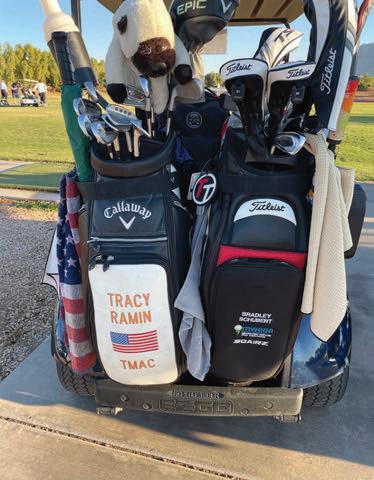
BY JASON HARROD, MA PHOTOGRAPHY BY DOUG PIKE

Dr.Tabbah has been with Hurley as a pediatric specialist since June of 2012, but has a history with Hurley stretching back to 1992. He completed his residency in pediatrics here from ‘92 to ‘95 before completing his pediatric gastroenterology residency at Emory University. He brought that experience and expertise back, where he now teaches in Hurley’s pediatric residency programs. Board certi ed in both pediatrics and pediatric gastroenterology, Dr. Tabbah can treat pediatric patients for a range of issues while specializing in caring for those with gastrointestinal diseases. When pediatric patients at Hurley Children’s Hospital need a consult regarding gastrointestinal issues, Dr. Tabbah is often called in to help. He also sees patients at the Hurley Pediatric Specialists Clinic located on Linden Road in Flint. Common issues that patients often see Dr. Tabbah for include foreign bodies in the esophagus and stomach, chronic abdominal pain, acid re ux, and liver and pancreatic disease. Signs to watch out for include unexpected weight loss or gain, inability to play and abdominal discomfort. Primary doctors or the Hurley Children’s Emergency Department can help identify these conditions and refer patients for specialty care in the clinic, though a referral is not always required.
With a sta that includes a registered nurse and a medical assistant, e Hurley Pediatric Specialist Clinic provides outstanding clinical care with low wait times. Dr. Tabbah explains, “ e Linden Road clinic is able to give

patients such a high level of service compared to other o ces because of the sta , and we’re able to do that with minimal wait times. So the patient and their family doesn’t have to go south to Ann Arbor or Detroit, where they would have longer wait times.”
Once he has diagnosed a patient, he is then able to work with Hurley’s nationally recognized sta and technological innovation to give patients the best treatment options available. One example is the capsule endoscopy, a procedure which has the patient swallow a small capsule containing a wireless camera that captures images as it moves through the small intestine. ose images are stored wirelessly on a recording device worn on the patient’s waist. Dr. Tabbah can then use those images to help diagnose or rule out a number of gastroenterological issues.
e combined resources of Dr. Tabbah’s specialization, the Hurley Pediatric Specialist Clinic and Hurley Children’s Hospital allow patients to get the comprehensive care they need right here in Flint, eliminating the need to travel for specialty pediatric healthcare.







BY PETER HINTERMAN PHOTOS PROVIDED BY KUHMUTE
Based in Flint, Kuhmute is leading the way in electric vehicle (EV) infrastructure providing a place for people to rent or charge an EV in cities across the United States and Canada. “We have hubs in Michigan in Detroit and Grand Haven,” says Kuhmute Software Engineer Eddie Wenzel, “and we have hubs in Illinois, Arizona and Ontario in Canada. We currently have nine in Flint with a plan in place for five more.” Kuhmute charging hubs are revolutionizing the way cities and towns think of mobility by providing a way for pedestrians to “motor” about town in a more fun and cost-efficient manner.
The venture is the brainchild of Kettering University graduate and business co-founder Peter Deppe. “At Kettering, a mentor of mine and I were looking for a startup to invest in,” he says. “In Michigan, we have limited mobility options and we also noticed that e-scooters and other small EVs were kind of a mess on city streets. So, we thought of a way to alleviate those problems.”
The idea was to build and fabricate electric charging docks to recharge, organize and secure the vehicles in a way that is beneficial for both the location and rider. “You can park and charge literally anything smaller than an electric car at a Kuhmute hub,” adds Deppe. The business was launched in 2018 and, after a few planning changes, is beginning to make an impact across the country.
Kuhmute hubs can work nearly anywhere including city lots, college campuses, apartment buildings, parking garages, hotels, airports and hospitals.
Kuhmute hubs are designed and built here in Flint by a dedicated team of engineers and associates from Kettering University and UM-Flint. In order for an EV to be charged by and secured to a Kuhmute hub, it must be equipped with a Kuhmute-designed nylon and stainless-steel adapter. The Kuhmute team is currently working to provide charging adapters for a variety of EV brands including Segway, Okai, Acton Nexus, Runner, Wagon and others (with more on the way as the team continues to design them). Kuhmute also has adapters available for some electric wheelchair brands, and is in the





“The goal is to have Kuhmute charging hubs located all over the world and we are working to get there.”

Co-Founder, Peter Deppe






process of building adapters for delivery robots. Each adapter is available at a cost of $100 each (with available bulk pricing). For a list of compatible models and brands, visit kuhmute.com.
Many Kuhmute hubs come with available EVs for rent. To provide a eet of rentable EVs to pedestrians, Kuhmute partners with other national businesses. In Flint, the scooters currently available for use are provided by New York-based EV producer, Helbiz.





One feature integral to the Kuhmute brand is “ease of use” and one needs only to download an app and tap on a screen to buzz your way around the city. “It really is very simple,” says Deppe. To start your rental experience, scan the QR code located on the sign above your local Kuhmute hub or download the Helbiz app directly and enter the required payment information. Next, select “start rental” and scan the QR code located on your chosen e-scooter to disengage the security feature and access the vehicle, then ride to your heart’s content! When your journey is over, simply plug the vehicle into any Kuhmute hub and click “end ride” on the app. Charging an EV that you personally own requires installation of the Kuhmute Charge app (and adapter). (Currently, functionality of this process is still being designed with hopes that it will be available in the spring of 2023.)
Need to get from Kettering to UM-Flint or the Downtown Flat Lot in a ash? Simply rent a Helbiz scooter and y! Have a compatible e-bike? Take a ride on the Flint River Trail, stop and charge your bike downtown while you get a bite to eat, then head on home. With the charging power of Kuhmute, you’ll never be without a reliable form of transportation to get you from here to there. “ e goal is to have Kuhmute charging hubs located all over the world,” says Deppe. “We are working to get there.”










BY PETER HINTERMAN


as long as he can remember, Mike Stormer has loved old and classic cars. “I’ve always been an old car person,” he says. “In 1987, was driving a 1972 Buick Electra and my mother rode around in a 1972 Delta 88 until 1988 or so. I loved those cars. It’s always kind of been my thing.” For years, Stormer cruised around in a 1970 Pontiac Catalina until an unfortunate accident retired the car. In his search for a replacement, Stormer found a unique ride that he wasn’t sold on at first. “Last summer, I found a 1949 Cadillac Fleetwood Series 62 for sale on Facebook and decided to check it out,” he remembers. “I wasn’t sure about it when I first saw it but the fact that it was so rare changed my mind. All my life, I’ve dreamed of owning a 1957 Chevy but there are already so many out there. I liked that this car was different.” Stormer took the Caddy home, made space in his garage and parked it inside. He had found his new classic. Since then, he has shown his vehicle at shows in and around Genesee County and even earned three awards. “It’s just a cool-looking car and I have only seen two others like it in Michigan,” he adds.
A military kid born in Florida, Stormer constantly moved around the U.S. following his father’s Naval career. “I had met my wife on a
military base where both of our fathers were stationed,” he shares. “Her family was from Flint and we decided to move to the area in 1991. They are classic car owners, as well – between all of us, we can have our own show! It definitely runs in our family.” His kids grew up to share his love including his son who has special needs, which led Stormer to an idea. “My son likes cars but doesn’t do well in heat or loud environments,” he explains. “So, I decided to take the show to him and his friends at his school, Marion D. Crouse, and to the kids at Elmer Knopf.” Stormer called up his friends and the group took their cars to the schools so the kids could see them, touch them, sit inside and take pictures. “We had about 15 cars and when the kids came out to see them, it was like Christmas morning,” he smiles. “My friends say it was the best show they ever did.”
That pre-pandemic show led to the only award he got for his Catalina. “It was voted the ugliest car,” he laughs. Stormer has plans to do it again during this upcoming school year but the schools ask that the show be limited to six cars. With new enthusiasm, he hopes to hold more small car shows at other local locations such as care homes for the elderly. “Some people have limited mobility and difficulty traveling but love classic cars,” he states. “I thought, ‘why not bring the cars to them?’” And this time, he will be rolling in with his Cadillac.
His 1949 Fleetwood is considered a “rat rod” (a custom car with a deliberately worn-down, unfinished appearance typically lacking paint, showing rust, ect.) and as such, is a different kind of car for Stormer. “Some consider a rat rod a poor man’s classic car,” he explains. “A traditional rat rod has been kept running with mix-and-match parts and has limited original pieces. Rat-rodding is a subculture within a culture. It’s the biker gang of the car world.”
Stormer’s Caddy has most of its original parts with some exceptions; including the engine and transmission. “It has a Chevy 350 engine and a turbo transmission,” he states. Named the “Ratillac,” his car was said to embody the “spirit of rat-rodding” by one judge at the




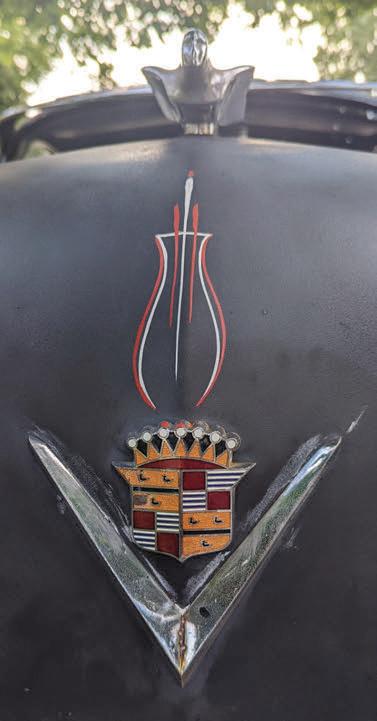
“It’s just a cool-looking car and I have only seen two others like it so far in Michigan.”
recent Sloan Museum Auto Fair where he won the Top Rat Rod award. “Another thing I frequently hear about rat rods is the old saying, ‘the rule of rat rods is there are no rules’,” adds Stormer. He went on to exhibit his car at the recent On the Road show in Burton where he again won the Top Rat Rod award, and at a small local show where his car took first place overall. It’s all very interesting, considering Stormer never meant to enter the Ratillac in competition at all. “I didn’t think it stood out, really. It was just a classic car to me,” he states. “I mean, at shows in the past, people would just walk by without even taking a look at it.” His mind soon changed after a recent show in Frankenmuth. “A guy told me I should have entered it to be judged on the previous day,” Stormer remembers. “I told him that it was just a car and the guy said, ‘You have a very cool car – don’t underestimate it.’ That made me appreciate it and I got to thinking about it.” At the Sloan event, he entered it as an afterthought and wasn’t even parked in the required area. “I didn’t even have my hood up when it was judged,” he laughs. “I didn’t know that was a thing. I was lucky that the judge hadn’t turned in his score yet. He came back to take another look.”
Needless to say, the Ratillac is here to stay and for Mike Stormer. “It’s the perfect investment,” he says. “This car is a survivor.”


BY PETER HINTERMAN
Before the cars, the bricks and the buildings, the roads and highways, and before the United States were established, a small footpath led the way from the lands of the Ottawa in the south (Detroit) to the lands of the Chippewa (Saginaw) in the north. Native Americans strode this path for centuries, up and down the state as they hunted, formed treaties, celebrated and settled. In the middle of this long and winding path owed Peiconigowink – “the river of the restone.” At the point where the path met the river, a rich history was born in 1811, when a fur trader named Jacob Smith built a trading post around which sprang up a city. e path, named the Saginaw Trail, became an iconic thoroughfare now known as Saginaw Street. is central path through the remarkable city of Flint was the setting for celebrations and parades, protests and upheaval, triumphs and tragedies. It perseveres, as Flint does, through changes both good and bad, still holding open the door for travelers coming home or simply passing through.
Chances are good that in 1811, Jacob Smith found his way to the Flint River via the Saginaw Trail as he headed north from Detroit, eventually nding the place on the river the French dubbed “ e Grand Traverse” and setting up shop. It wasn’t until 11 years later in 1822
that the rst road to Flint from Detroit was created by soldiers blazing their way to a fort in Saginaw using the tribal footpath as a guide. e road was little more than a bridle path, but widening and clearing the original path led to an in ux of pioneers to Flint and the establishment of the city. As pioneers arrived, built homes, mills and shops, the road was widened to accommodate them and their wagons. In 1833, the road from Flint to Detroit was paved with wooden blocks and in 1841, the Flint to Saginaw section was nished in the same manner.
In 1850, a new type of road was being aunted in cities and counties throughout the state and Genesee County had an eye for innovation. Called a “plank road,” it consisted of covering a route with a layer of wood planks laid upon timbers placed lengthwise on a graded road bed. Two companies made plans to turn Saginaw Street into a plank road. e Genesee County Plank Road Company proposed to make this change from Flint to Grand Blanc and the second, the Saginaw & Genesee Plank Road Company, planned to plank Saginaw Street from Flint all the way to the Saginaw River. While the former failed in their endeavor, the latter was successful. e new Saginaw Street was nished in 1852 and bene tted the region

1811
Jacob Smith built the trading post that gave rise to the City of Flint.

1833
1852


First

Road from Flint to Detroit was paved with wooden blocks. The Flint to Saginaw section was finished in the same manner.
1822
traveling to the city of Saginaw until the installation of the Pere Marquette Railroad. e new plank road was installed on Saginaw Street north of the downtown stretch. e parcel downtown continued to be paved with wooden blocks.
Saginaw St. then remained unchanged until 1870 when future mayor William Hamilton got cheeky. It was his plan to lay tracks across Saginaw St. for the Grand Trunk Railroad, but he knew the city council would most likely turn down his proposal. So, Hamilton had his men put down tracks across the street on the weekend before Monday’s council meeting and before they could object to his plan. e Grand Trunk Railroad began traveling from Huron to Flint in 1871.
1841
Saginaw Street turned into a “Plank Road”

William Hamilton laid train tracks across Saginaw St.

1870
In 1897, Mayor Milton C. Pettibone took a major interest in Saginaw St. as a main thoroughfare and began


the process of paving the street with bricks. While in ofce, he signed ordinances clearing the streets and making them more accessible to pedestrians by building sidewalks. He also allowed for street railways to be built for trolleys operated by George E. Taylor, Joseph E. Sawyer and Samuel W. Smith. e street was bricked in sections and the entire project was nished in 1898 during George R. Gold’s administration. e street was made an iconic part of the city by Gold’s successor, Hugh A. Crawford, when he erected the famed Saginaw St. arches in 1899. e origin of the rst bricks laid on Saginaw Street is a mystery. Flint had its own number of brick manufacturers during the time period, including Alexander Ward’s company and M. C. Barney’s Brick Co. However, it’s more than likely that the original bricks were supplied by the Nelsonville Brick Company out of Ohio which opened in 1877 and



Mayor Milton C. Pettibone began the process of paving the street with bricks.

Over the next two years, the Saginaw St. restoration project – replacing 750,000 bricks – will be done block-by-block from the Flint River to Court Street.
Hugh A. Crawford erects the famous Saginaw St. arches.



The brick project was finished during George R. Gold’s administration.
closed in 1937. (Indeed, many bricks carry the Nelsonville stamp; but were they the originals or used during the later re-pavement project?)
In 1936, President Roosevelt’s Works Progress Administration (WPA) came to town to begin the Saginaw St. restoration. Bricks were pulled up and some were reused, yet most were discarded. e endeavor used over 750,000 bricks and cost today’s equivalent of $3 million to complete. During reconstruction, the WPA removed the rail system and Flint contracted with Laro Coal & Iron to purchase them for $13.50 a ton. e railway cars were replaced by General Motors Electric Trolley Coach Service. Since then, Saginaw St. has existed much the same with slight improvements, patching and consolidation (bricks were removed from side streets).
Due to start this fall, the Saginaw Street Restoration Project will take the road to its next form.


President Roosevelt’s Works Progress Administration (WPA) began the Saginaw St. restoration.


Due to start this fall, the Saginaw Street Restoration Project will take the road to its next form. At a cost of nearly $5.8 million over two years, the project will remove the bricks in Downtown intersections and replace them with stamped pavement (for better stability) while re-working bricks over the rest of the stretch. In addition to street resurfacing, improvements to around 70% of the sidewalks are planned. Just as in the original project in 1898, the process will be done one block at a time.

Saginaw Street has remained a path of signi cance during human history in the Americas; it has been a path to greater things, a path of community and for Flintstones, no matter its construction, the road home. Whatever the future holds in store for Flint, the bricks of Saginaw Street will take us there.














BY PETER HINTERMAN
From the mid-1940s to the beginning of the 1960s, Flint was operating at peak e ciency and success. General Motors was nearly unrivaled in car production, Flint schools were the envy of the state in both education and sports programs, impactful social groups and organizations were being started, infrastructure updated and major businesses were built. Parades and celebrations dotted the time period between multiple visits from presidents and presidential hopefuls on the campaign trail. It was also during this time that Flint proved to the nation how resourceful and close-knit a community could be after the Beecher Tornado ripped through in 1953 and disrupted hundreds of lives. e mayors of this time period had to simply sit back and let progress happen and were mostly concerned with necessity improvements (water) and expansion.
is series has tracked each of Flint’s mayors throughout history, providing a short account of their professions, lives and decisions in o ce (if known). Some mayors were men/women of great deeds or of great controversy; some simply acted as placeholders in time. Each of them, however, chaired a city important to its country and citizens on a path through triumph and heartbreak, and toward revitalization.
For Part 1 in this series, see the January 2022 issue of MCM.
Born in Chicago, IL in 1889, McLogan moved to Calumet, MI at the age of nine. His father, John C. McLogan, owned and operated music stores under the name of McLogan & Pierce with locations in Calumet, Hancock and Iron Mountain. Edwin McLogan learned the ways of business working for his father until the breakout of World War I when he enlisted in the United States Army. He was promoted to major of the 10th U.S. Infantry and commanded his regiment through many important campaigns in France. After the armistice, McLogan stayed for a time in France, returning home in 1919. Months after his return, he moved to Flint to start a business with his partner Edward D. Austin. Within a year, they opened The China Closet at 517 S. Saginaw St., (near the current location of Blackstone’s Smokehouse) selling fine china and dinnerware. In 1938, he became a member of the Genesee County Board of Supervisors and as mayor, he lobbied heavily to bring more natural gas to the city to help heat the new developments and homes. McLogan was a member of the rotary club, Order of the Elks, a Noble of the Mystic Shrine, and Freemasons. During his tenure, Flint was operating as a big-time producer of tanks and weapons of war with nearly every factory converted and dedicated to the effort. On August 14, 1945, a spontaneous victory celebration erupted in the city followed two days later by a victory parade. Also during this time, the Big Brother Association was started by Joseph T. Ryder and the Mott Foundation moved into the Union Industrial Bank building where it now resides. Edwin C. McLogan died in 1949.
Born in 1890 in Plattsburgh, NY Viall grew up and became an engineer with the Lozier Motor Company which specialized in luxury cars. During his short time with the firm, Lozier produced the nation’s most expensive vehicles. The company would close in 1918, sending Viall to Flint as an engineer at General Motors. Being civic minded, he served on the city commission and then as mayor, guiding the city through its worst flood in 1947. In 1939, Viall released a book of poetry entitled An Evening In … and other Poems, to be followed by three more: Passing Through (1940), Yankee Spirit (1942) and Looking Forward (1944). His poem “To the Blue Star Mothers” was read in Congress to honor the Blue Star Organization. The final verse reads:
“So, let’s pay an honored tribute, To the mothers of today, Who have within their window, A blue star upon display. Let their names go down in history, As an army strong and great, For they also serve their country, Who just stand aside and wait.”
Edward J. Viall died in 1950.
George Gill Wills was born in 1903 in Houghton, MI. After graduating from Michigan State Normal College, he settled in Flint, took on multiple civic opportunities and served on the city commission. As mayor, Wills was concerned with increasing housing opportunities in the city and lobbied Congress on a few occasions to pass a National Housing Bill that would assist the city in the construction of low-rent public housing. After taking office, he greeted Harry S. Truman and conducted a parade for the president during his election campaign. In the winter of 1949, Wills declared a state of emergency during a city-wide coal shortage in an attempt to bind dealers and consumers to a rationing plan in order to keep city residents from freezing. It was reported that some 200 families were in dire need of heat. In 1961, Wills made one more attempt at public service and was a primary election candidate for Michigan State Constitutional Convention delegate. Wills died in 1983 and was buried in Gracelawn Cemetery.
Paul C. Lovegrove was born in Pennsylvania in 1910. He was elected mayor after a bitter fight for control of the city commission pitting a joint effort of the UAW-CIO and the Flint Fair Employment Practices Commission (FFEPC) against General Motors. After the war, the UAW-CIO held a slim majority in the city commission and used its slight majority to protect workers’ rights. Heading into 1950, the FFEPC was fighting against discriminatory employment practices centered on GM factories. They aligned with the UAW-CIO to hopefully gain advantage in the city commission in order to pass fair employment legislation. GM united with Flint Journal Editor Michael Gorman to select and push probusiness candidates. The UAW-CIO subsequently lost its advantage in the commission; Lovegrove, backed by GM, was chosen mayor. When the vote to pass fair employment legislation came up in October of 1951, it was defeated 6-3. Lovegrove defended his negative vote by asserting that the legislation would drain city coffers and that it was impossible to “legislate away” racial prejudice. During the same year that Lovegrove was passing his vote, McLaren Hospital opened in Flint.
Born in 1917, Donald W. Riegle, Sr. was raised, from the age of 11, in Davison Township having been adopted after his mother’s marriage to John L. Riegle. (His biological father, Roy Tenny Smith was an AC Spark Plug worker from the thumb area of Michigan.) Riegle’s father opened and established the Riegle Press of which Donald dedicated his life to as sales representative and officer. Backed by General Motors, Reigle, Sr. served as a pro-business city commissioner from 1950-52 and was subsequently chosen mayor. Politics in Flint were hot-blooded and, being thought of as a GM pawn, Riegle was serving as commissioner when an unknown assailant took out the front window of Riegle’s house with a shotgun. Riegle’s term as mayor was loaded with excitement and tragedy. He welcomed Harry S. Truman on his second visit and in 1953, the first Corvette rolled off the assembly line. In perhaps Flint’s biggest celebration, Riegle and the city saluted GM’s 50-millionth car with a grandiose parade. Tragedy struck on June 8, when the Beecher Tornado touched down killing 116 people, injuring more than 900 and destroying more than 300 homes. The response from the city government and its people was nothing short of heroic, however. The effort earned the city the “All-American City Award.” Donald W. Riegle’s son, Donald Riegle, Jr., would go on to become a United States Representative from 1966-1976 and senator from 1976-95. Donald W. Riegle, Sr. died in 1992.
George M. Algoe was born in Flint in 1898, the son of tinner J. Frank Algoe. He worked as secretary, treasurer and partner of the Algoe-Gundry Company Funeral Directors – the county’s oldest such establishment (located at 703 Beach St., now demolished). As mayor, Algoe was industrious. His tenure began with the launch of the Flint Cultural Center Project, which established the Flint Institute of Arts, planetarium, Whiting Auditorium and more. In 1955, Flint Junior College (Mott Community College) went into operation and the city’s centennial celebration, dubbed the Golden Carnival, attracted more than 200,000 spectators including Vice President Richard Nixon who dedicated Flint’s new Municipal Center. At the time, Algoe stated, “the dedication of this magnificent Municipal Center is a time of triumph” and, the “structures will remain as a testament to those that follow us that we build well the foundations for the future.” He then bragged that Flint was the “envy of all other industrial cities.” The next year, the University of Michigan-Flint opened its campus. As soon as he took office, Algoe began working on a new municipal center and found engineers Robert Moses, William S. Chapin and Gilmore D. Clarke to choose its location and initial design. A citizen committee selected the firm of H. E. Brewster and Associates to finalize. Algoe was able to get the new city hall finished and opened in April of 1958. After his death in 1968, it was proposed to name the I-475 expressway in his honor.
When Robert J. Egan took the reins as mayor in 1958, the City of Flint and General Motors were gearing up to celebrate GM’s 50th anniversary. The city was flying high and everyone was happily praising the future. Egan was perhaps the first to see cracks forming in the foundation. At the beginning of his term, Flint was experiencing nearly 14% unemployment (today’s rate is roughly 6%) and people were beginning to leave the city for the suburbs, taking their tax money and expertise with them. When Flint began to extend water out to the suburbs before he took the helm, Egan warned that businesses would follow and that water supply would become a major problem. Unfortunately, he was correct. In an attempt to slow future problems in 1959, Egan, as a representative of the American Municipal Association, lobbied congress to pass H. R. 5944, known as the Community Facilities Act, to help the city install new water infrastructure. With the money the act provided, Egan stated that Flint could start the process of building an aqueduct from Lake Huron to provide a larger source of water. Arguments were made against the money being given to Flint because, it was claimed, Flint was not a poor city. This was true. Flint had a population of over 200,000 persons and taxes were being collected at a rate of 97.8%. Egan was looking to the future; Congress was looking at the ledger. Egan also worried about being tied to one industry only, realizing that at any moment, GM could leave or automobile sales would end. In answer, he formed a committee to work for a diversified industry base in Flint. History will show his efforts were too late. Egan also dealt with the city’s first major civil rights protest when a young, black woman was arrested for loitering despite claims she was simply walking home. It was the first sign of major tension and social change in the city. In 1958, the Flint Public Library opened its doors and the first Buick Open took place at Warwick Hills Golf & Country Club. In the summer of 1959, Egan opened Southwestern High School to its first students.
When John F. Kennedy spoke in 1960 at Atwood Stadium about the dangers of automation for a working city like Flint, Mayor Charles A. Mobley listened. He, like Egan before him, was concerned with Flint’s future, especially as automation was concerned. Employment continued to fall in Flint and the citizen exodus to the suburbs was continuing. Mobley hitched up his belt and made his way to Congress where he lobbied for H. R. 4569, known as the Area Redevelopment Act, in an effort to acquire federal funds to create a program to retrain employees supplanted by automation. His efforts went the way of Egan’s for much the same reasons. Meanwhile, the cracks in Flint’s automotive foundation were getting wider and neither Mobley nor Egan could even begin to patch them. While in office, Mobley created a Department of Industrial Development in another effort for diversification. This effort continues without much success into today. After his tenure, Mobley ran for state representative twice in 1962 and 1964. He served as a long-time member of the Parks Board and Mobley Park, located across from Powers Catholic High School, is named after him. Also, during his mayoral term, Flint hired Joe Davis, the city’s first black fireman.


DOWNTOWN
FLINT 8.13.2022
PHOTOS BY JADEN MOXLOW
The skies were gray, but the high-energy music was thumping at this one-of-a-kind and colorful, all-day street fair. Thousands of electronic music fans, musicians, artists, designers and creatives gathered to celebrate 10th Annual Flint Drop Fest. In addition to food trucks, dozens of art and craft vendors, live art, fire dancers and belly dancing, attendees enjoyed local, regional and national musical talent performing a variety of genres on multiple stages located throughout Downtown Flint. Sponsors of the free event include Charles Stewart Mott Foundation and Greater Flint Arts Council.
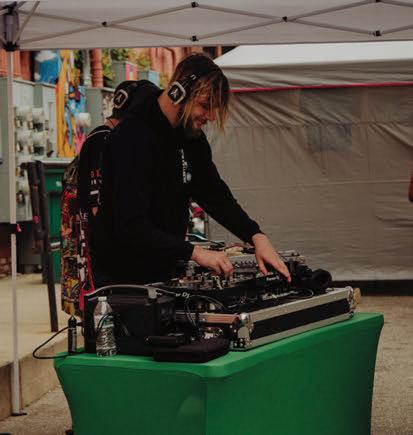


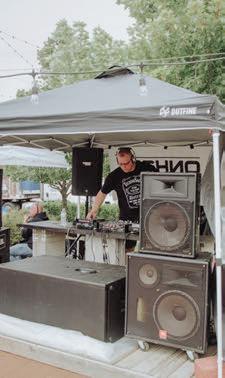








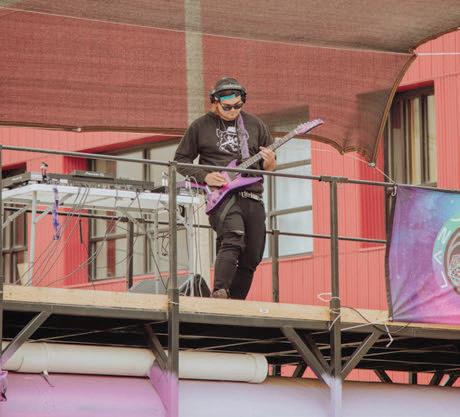




VARIOUS LOCATIONS 8.17.2022
BY
JADEN MOXLOW
From bagels and barbecue to sliders, Italian and Mediterranean cuisine, nearly 20 Fenton and Linden eateries served samplings to hundreds of hungry tasters. Traveling between three regions of tasting stations, participants in the unique dining experience had their Traveling Taste passports stamped to enter in a grand prize drawing for gift cards from each restaurant.
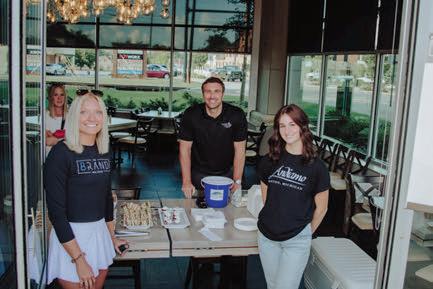







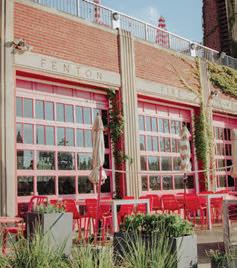

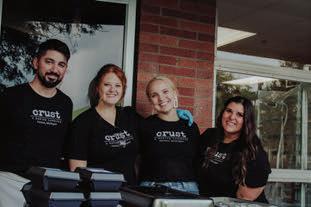

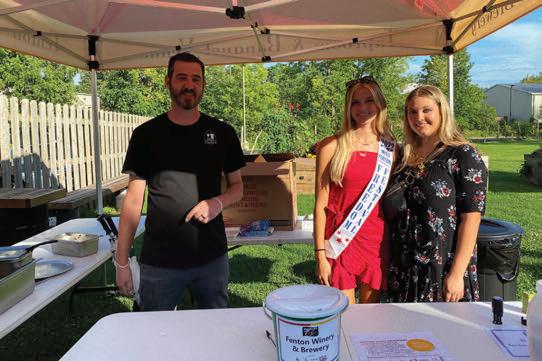

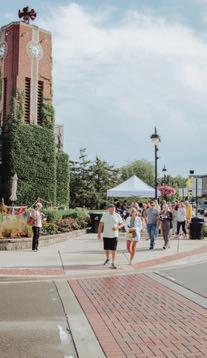
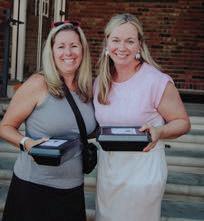
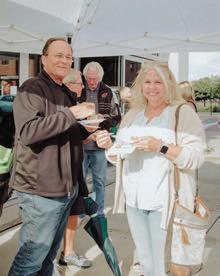

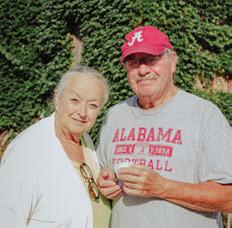

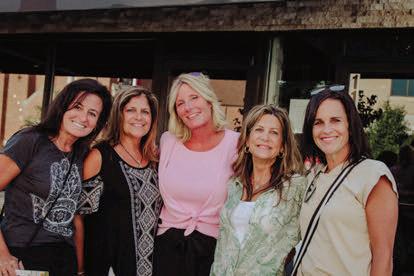
8.12-13.2022 THE DURANT
PHOTOGRAPHY BY KATY KILDEE
On a balmy summer weekend, a group of over 60 “Edgers’’ ascended to the roof of The Durant in Downtown Flint to participate in the only global industrial rappelling event to bring visibility and increased awareness to the disability community. With Back to the Bricks as a backdrop, Over the Edge helped raise funds for The Disability Network’s essential programming that helps people with disabilities in Genesee County live independently. MyCityPublisher Vince Lorraine and his daughter Courtney Lorraine buckled up for the second time. This inclusive and accessible event is the organization’s single biggest fundraiser.





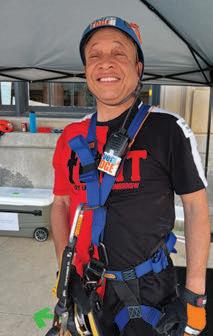

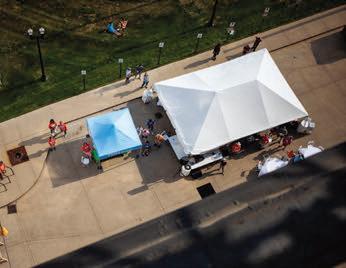
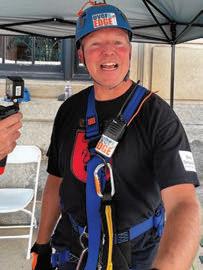
NOTABLE “EDGERS” INCLUDED LINNELL

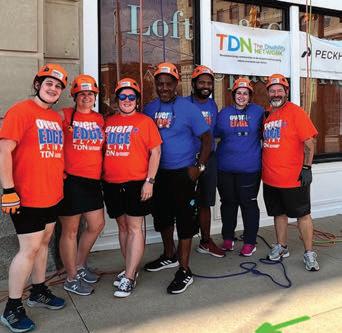

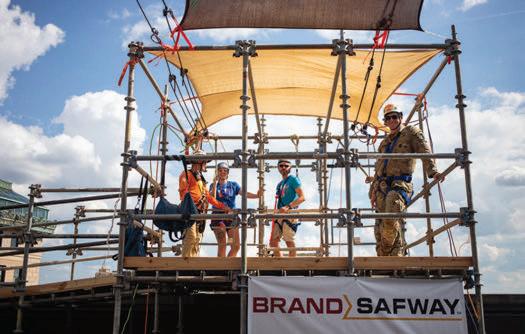







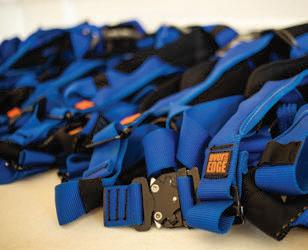



GENESEE COUNTY/DOWNTOWN FLINT 8.8-20.2022





All roads lead Back to the Bricks®! This event attracts over 500,000 car show enthusiasts annually to Genesee County for a celebration of our love of motor vehicles and the area’s historic role in the auto industry. After a Tune-Up Week of themed parties held throughout Genesee County, the five-day extravaganza continued with rolling cruises and other family-friendly fun. During the week, “America’s Sports Car” was saluted with a National Reunion for Corvette aficionados. As always, Saturday’s Main Event (blessed by a bit of rain) showcased hundreds of classic, custom and collector vehicles of all kinds, and the bricks of Downtown Flint were alive with food vendors, music and folks enjoying a summer festival like no other!





























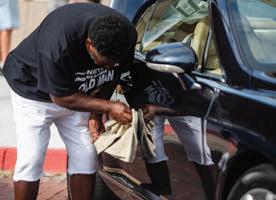


















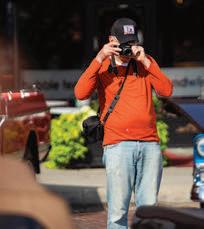













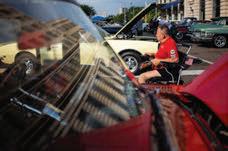






BY VERA HOGAN
Inmy July column, I mentioned that when I was a kid, I saw Creedence Clearwater Revival at a campground bandshell, long before anyone ever heard of them. That was just one of my early musical experiences.
When I was a high school freshman, I often walked to a girlfriend’s house a few blocks from mine in Niles, IL. On one of those walks, I noticed a very cool car down her street. e guys climbing into the convertible had long hair and were dressed in purple velvet suits with a riot of pink ru es spilling from the fronts of their jackets. I remember thinking, “How dumb! It’s the middle of July. ey must be sweltering in those out ts!” ose guys were e Buckinghams – they sang “Hey Baby ( ey’re Playing Our Song).” One of the members, Nick Fortuna, lived in that house.


Years later, I lived in an apartment complex adjacent to a small shopping center in Wheeling, IL directly across from a bar called Haymaker’s. My friends and I often hung out at that bar where we frequently enjoyed live music played by Illinois rock band, Cheap Trick. Between sets, the band members always sat and drank beer with us. is was before they became famous.
I have enjoyed many concerts, too many to name; but they include e Rolling Stones, e Who, Led Zeppelin, REO

Speedwagon, Jethro Tull, Fleetwood Mac, Alice Cooper and many others. But my absolute favorite was and still is e Moody Blues. e last time I saw them was with my late husband’s cousins. Before we found our seats, one cousin told us to “wait a minute” and then disappeared behind an unmarked door. A minute later, he opened the door and motioned us inside. It was his company’s private suite. Not only were we able to enjoy free adult beverages and a vast array of hors d’oeuvres, I was able to step out onto the balcony and practically touch lead singer Justin Hayward during the concert. I was in heaven!
My stepson and his wife love attending concerts more than I ever did. What I learned from them is that for an additional fee, some bands will host “meet and greets” when you can actually meet the band members and get a picture taken with them. ey have paid $1,000 or more for the privilege. WHAT? How long has this been possible? ey have been able to meet all the members of Poison, Aerosmith and Foreigner, as well as Mick Fleetwood of Fleetwood Mac, Ozzy Osbourne and a few others, and they have the photos to prove it. ey say you can get information about meet-and-greet opportunities through your ticket-purchasing source.

In late July, Cheap Trick performed at Pine Knob Music eatre in Clarkston. e VIP meet-and-greet tickets ranged from $1,500 to $3,000! And to think I bought pitchers of beer for those guys.


Recently retired, Vera Hogan is a 20-year veteran of the newspaper business, having served both Fenton and Flint area publications. During those years, she was a reporter, associate editor, editor, web content editor and columnist. Her popular columns have earned her multiple state awards. She resides in the City of Fenton. Email verahogan@hotmail.com.










BY DR. CHRISTOPHER DOUGLAS


Real gross domestic product (GDP), which is the in ation-adjusted nal value of all goods and services produced in the United States, declined by 0.9% in the second quarter after declining by 1.6% in the rst. Two consecutive quarters of GDP decline is the de nition of a recession found in any “introductory economics” textbook, despite the attempts by some to rede ne the term. Since the end of World War II, a recession has been called by the National Bureau of Economic Research’s Business Cycle Dating Committee every time the economy has contracted for two consecutive quarters. Consistent with the traditional de nition of a recession and past practice, the economy is in a recession.
Some argue that the strong July jobs report and the unemployment rate being at 3.5% means the traditional de nition of a recession no longer applies. is argument misses some key points. First, jobs reports have been strong at the onset of a recession as employment lags the broader economy. December 2007, the rst month of the Great Recession, saw over 100,000 new jobs created. Second, the economy only just returned to February 2020’s employment level. Had the 2020 shutdowns not occurred, employment would have likely continued to grow by approximately 150,000 jobs per month leading to four million more jobs over-and-above our current level. ird, in ation-adjusted wages have fallen in 2022. Wages are up by 5% but in ation is 9%, meaning workers’ purchasing power has fallen by 4%. If the economy contracted for two consecutive quarters, lost four million jobs and saw wages fall by 4%, a recession would be undeniable. However, for all intents and purposes, this is where the economy is right now.


Two common causes of recessions are sharp increases in the price of crude oil and the Federal Reserve tightening to reduce in ation. Both have

preceded nearly every post-World War II recession and both have occurred at severe levels in 2022. Interest rates have doubled and crude oil is up by nearly 50%. Both were avoidable problems and consequences of negligent economy policy during and post-pandemic.
When businesses were forced to close, people’s jobs and businesses were destroyed. Rather than reversing course when it became apparent that the shutdowns were not attening the curve, policymakers doubled down, extended shutdowns into 2021, and tried to back ll the loss by printing trillions of new dollars and pouring them into the economy through three rounds of COVID “stimulus” spending. It should not surprise anyone that nancing massive increases in government spending through doubling the money supply led to in ation, but apparently it surprised policymakers, Federal Reserve o cials and some academic economists. U.S. foreign policy has made no e ort at peace negotiations in Ukraine and instead have poured billions of dollars worth of weapons into the con ict, destabilizing world oil and food markets and risking broader geopolitical con ict.

Americans have been through a lot over the last two years and deserve to be in a better place in 2022.

Dr. Christopher Douglas came to the University of Michigan-Flint in 2006. He earned a B.S. in Electrical Engineering and a B.S. in Economics from Michigan Technological University in 2001, and his Ph.D. in Economics from Michigan State University in 2007.

As Associate Professor and Chair of the Department of Economics, he teaches Principles of Microeconomics, Principles of Macroeconomics, International Economics, Public Finance, and Sports Economics.



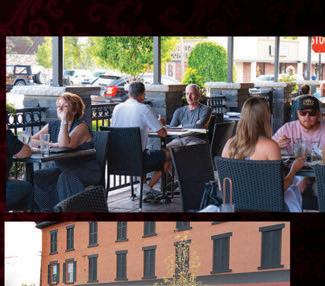

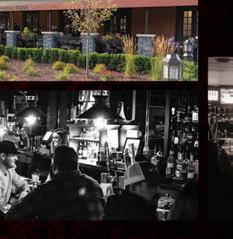




BY LESLIE TOLDO
Thanks to Facebook, I have reconnected with friends I have known since grade school. I know what is happening in their lives, and they know the latest details about mine.
I know where some of them stand on politics and current events, for better or worse. We message. We joke. We comment on each other’s posts. We just don’t see each other very often. Most of my oldest and dearest live in Louisiana, which makes getting together in person tricky … and expensive.
I just returned from a trip down south. I had the best time at a get-together with about a dozen girls I grew up with. I was staying at the home of one friend, and as I helped her clean up after the party I said, “You are all so lucky! You can get together anytime you want.”
“We don’t,” my friend Alicia replied a little tentatively.
“How can that be? If I lived down here, you would see me all the time. You would be sick of my face,” I almost shouted.
No sooner did those words come out of my mouth than I remembered I have some great friends in Michigan whom I have known for nearly three decades, and I haven’t seen most of them in years.
The ugly truth is: we get lazy. It is so easy to stalk an old friend’s Facebook profile to find out how they are doing and what is happening in their lives, that I seldom even call these great friends on the phone. I want to believe that it is just what happens when you live hundreds of miles apart, but I know that’s not the case.
When I was growing up, my Uncle Ken lived about 30 minutes away from my home. He and my mother were close,
but we only saw him once a year at Christmas for a few hours. I once asked her why and she said, flatly, “We’re too busy.”
Are we too busy? That is the go-to excuse for not doing all sorts of things. I am not trying to say that we aren’t busy, but I am reminded of a really annoying thing my high school drama teacher used to say: “One does what one wants to do.”
It all comes down to priorities.
Of course, our lives are full – between work, family, taxes and trying to get the recommended 30 minutes of exercise at least five days a week; but making time for what makes us feel good should fall somewhere on that list.
As I sat in my friend’s living room surrounded by these women I have known and loved for almost my entire life, I felt this sense of ease. I felt complete. Why wouldn’t I make time for these beautiful people who have really become more like family? I don’t mean making time to look through their Facebook posts, but setting aside some time to hug them, look them in the eyes and know how they are really doing – not just what they are posting.
Who doesn’t have time for that?

An Emmy-nominated anchor/meteorologist/ reporter at FOX66 and NBC25, Leslie Toldo has worked in TV news for over 30 years, nearly 20 in Flint. She is a blogger, writer, wedding and funeral officiant. Born and raised in Baton Rouge, LA, she graduated from the University of Wyoming. An avid kayaker, boater and runner, Leslie lives in Linden with her husband, Ellie the cat and three dogs: Bear, Gus and Lucy.










































































UBY JOEL LAGORE, CFP®, AIF®

ntil the previous year, the concept of economic in ation was nothing more than a good story the older generation would hold over everyone else’s head. Back in the early ‘80s, it wasn’t in ation that made people very uncomfortable with managing theirnances, it was the Fed’s policies to combat in ation that forever changed an entire generation’s view of debt. ose people in America who held mortgages or loans during the early ‘80s are not nearly as comfortable with holding debt as most of the generations that have come after them. We cannot blame them for being so averse to holding loans unless completely necessary; mortgage rates topped out at 18.63% in October of 1981 but stayed at almost 10% through the end of 1989.
To understand why controlling in ation is of utmost importance, we rst need to understand what it is. In economic terms, in ation is the rate of increase of prices for things we purchase over a given period of time. We can view this both positively and negatively. From a positive position, all things that we own – home, investments and cars – increase in value but at the same time, our ability to purchase things with each dollar decreases. Discussing the causes of in ation can become pretty complicated and over the past year, the subject has been debated quite a bit because it seems to be caused by a combination of factors. Most of the in ation issues seem to stem from COVID and the e ect it had on our economy. A period of increased costs for production due to supply chain issues and salary increases has made it much more expensive to make things post-covid vs pre-covid. We also saw a large increase in demand coming out of the pandemic, when people had additional savings and an increased appetite for spending due to lockdowns. In order to help put money into the economy to help businesses get through the COVID slowdown, we also saw a staggering increase in money supply in the form of multiple stimulus packages. No one truly knows which of





these factors has had the most e ect on us reaching our current, almost 40-year high in ation numbers; but it is safe to say that in ation does not seem to not be going away as quickly as everyone hoped it would.
So, how is in ation controlled and by whom? e way to reduce in ation is by reducing the purchasing power of the people – this can be done by either the Federal Reserve or to a lesser extent, the U.S. government. Not to get too deep into the weeds, but the Fed can either raise or decrease rates to make borrowing more or less expensive, or they can increase monetary supply by buying or selling Treasury bills. e U.S. government can also increase taxes, giving taxpayers less disposable income. Any type of bill that claims to help decrease in ation could potentially do the exact opposite by signi cantly increasing monetary supply again.
Why is controlling in ation important? e U.S. is currently the world’s reserve currency, meaning that most countries do all of their trading with U.S. currency and most hold their cash in some type of U.S. currency or bond. If in ation were to spin out of control and our currency devalue vs the rest of the world, it could lead us down a path of no longer being the currency that the rest of the world wants to hold.
So, as we head into mid-term election season and are inundated with nger-pointing on both sides of who did what and who caused what, let us remember that going forward, there is only so much that either political party can do to control something as signi cant as in ation.
HTTPS://FRED.STLOUISFED.ORG/SERIES/MORTGAGE30US
HTTPS://TRADINGECONOMICS.COM/UNITED-STATES/MONEY-SUPPLY-M0
HTTPS://WWW.INVESTOPEDIA.COM/ASK/ANSWERS/111314/WHAT-METHODS-CAN-GOVERNMENT-USE-CONTROL-INFLATION.ASP

Joel P. LaGore, Certified Financial Planner and partner with OLV Investment Group, focuses on money management. Joining the Downtown Flint revitalization effort, his office is located in The Durant at 607 E. Second Ave., Suite 100. Joel and his wife Sonya are raising two daughters in Flushing, where he enjoys philanthropic pursuits in his local community, in Flint at large and in Genesee County.

vitality and it would be wise to rebrand Flint to become known for its unique commitment to arts and culture, just as other cities with similar infrastructure have done such as Santa Fe, New Mexico or Grand Rapids. Flint’s arts and culture scene is the golden goose that can make it happen.”
Re ecting on his career in Flint, Henry takes great pride in all that he and his team have accomplished. He has seized every opportunity to better the FIA and its school for its patrons, students, and the community at large. “If I had to choose, I would say I am most happy about the reputation and function of the school and our perseverance in getting things done despite di culties,” he says. “My career has been very rewarding and enriching. It provided a good life for me and my family. Janice and I have lived in interesting places and traveled the world developing wonderful relationships along the way.”
While now is the time in his life for Henry to relax, you can be sure that he will have an eye on Flint, if from a distance. “We will be around in the short term but will probably end up closer to our children, someplace warm and living happily ever after,” he states. “My retirement is the end of the chapter for me, but not for the FIA. e FIA’s story has many more chapters yet to be written.”
Congratulations, John Henry! On behalf of Flint and My City Magazine, thank you for your many contributions to our city’s robust and vibrant arts community.







BY CHERYL DENNISON


Going to Parris Island, SC to watch my grandson Mack graduate from the U.S. Marine Corps boot camp is a memory I will always cherish. On August 5, he o cially became a U.S. Marine with the 1st Battalion Charlie Co. PLT
1054 after successfully completing e Crucible, a grueling and intense 54-hour event that tests recruits physically and psychologically on limited sleep, the nal challenge of their training.
Mack had just turned 18 when he decided to join the Marines and left for boot camp on Mother’s Day with just the clothes on his back, his driver’s license and $20 in his pocket. His mom, my daughter Melissa, was terri ed for him. Writing letters was the only way to communicate with him for three months, so you can imagine how excited we all were to see him again.





Family Day began with a Motivational Run at 7am and was our rst opportunity to see our Marine. It was very hot and humid and our emotions were high. Proud families, many wearing T-shirts that identi ed their Marine, lined the roadside and cheered as they passed us. Tears began to ow when we spotted Mack. After the Liberty Ceremony at the Peatross Parade Deck, the new Marines were at liberty to spend the day with their families. It was very emotional to watch Mack hug his mom and all of his family members – and more tears owed.
Graduation Day was held on Friday morning. While waiting for the outdoor ceremony to begin, the sky turned dark and rain began to fall so the ceremony was moved indoors. Not thinking that we might need an umbrella, we all got soaking wet! It was an honor to watch as the proud young men and women, dressed in uniform, marched in. e announcement of each platoon was met with wild cheers and applause. e somber ceremony was very moving, starting with words from the Commander of Troops.

After the ceremony, we went to the barracks to get Mack’s bags. He introduced us to some of the other Marines. One introduced his parents to Mack, telling them that

DOMERESE EMBRACES

HIS MOM, MELISSA.




he would have never made it through boot camp without Mack’s support (proud moment). After having lunch with another Marine and his family, we were ready for the long drive back home to Michigan – an opportunity to hear about Mack’s boot camp experiences. Some were funny and some were not very pleasant. Some of them were very intense, especially when he shared the trials he faced going through e Crucible and how ecstatic he was when he realized he had made it; he was no longer a recruit – he was a Marine.



In the letters he wrote from boot camp, all Mack talked about was the food he wanted to eat when he got home. On the drive home, the rst thing he ate was a McDonald’s cheeseburger. He said he couldn’t wait to get home to enjoy some of his mom’s home-cooked meals.
After ten days of liberty and a whirlwind of activity, Mack boarded a plane and left for Camp LeJeune, NC to continue his training. A transformation occurred in my grandson that was amazing to see. He left for boot camp as a teenager, somewhat nervous and a little scared. He came back tanned and muscled, standing tall, proud and con dent. He had overcome many fears, developed great faith and was prepared to face his new life as a U.S. Marine.



▶
I make my music and I’m creative and expect nothing in return. Whatever happens is cool with me.” Since performing solo as Fernando Silverio Solis, he has opened for notable acts such as Craig Owens (Chiodos, badXchannels) and Mike Kinsella (Owen, American Football), has played numerous local shows in Flint and Detroit and gained a whole new fan base. e acoustic guitar, he is proud to say, is nally here to stay.
Recently, Solis put together a new band: Fernando Silverio Solis Y El Sueño with John Guynn (guitar), Jacques Doucet (guitar/slide), Austin Conquest (bass) and Ryan Gregory (drums) to help expand his new sound. Out of all of his past confusion and chaos, Solis has made his peace with music. So, is he happy here? “I am happy. Here is pretty good,” he says with a smile. “After all of it, it’s the tenacity that comes from being a part of Flint that has helped me continue creating. It’s a part of everyone here. It’s in our blood.”
e music of Fernando Silverio Solis is available on all streaming platforms and YouTube, including his newest album “Somebody at You Keep Around,” past favorite songs “Are You Happy Here” and “When the Good Starts to Fade” and more.
For live performance and new music information, visit Fernando’s Facebook page. See Fernando Silverio Solis Y El Sueño on October 22 at Flint City Hard Cider with e Claudettes and Pato Y Pato.






BY ALEXANDRIA NOLAN
This summer, I took my son to Spain. It was my rst time returning since before he was born, and his rst time meeting his godmother who lives in Barcelona. Traveling alone is not for the faint of heart; but a trip abroad with a small child as your companion is only for the truly insane.
I booked a hotel room in the middle of the Eixample near to the Passeig de Gracia, the area’s high-end shopping district. I would not typically opt for a place so touristy, but being a mom carrying a child on her hip down the street – well, it seemed safer.
On our rst day in Spain, after arriving and napping the day mostly away, my son’s godmother and my close friend came to meet us at the hotel, and after muchos besitos and enough hugs to ll ve years apart, we spent the rst night at a vinateria, drinking wine (grape juice for one of us) and catching up. My son, the well-traveled young man that he is, took everything in stride. Walking down winding, centuries-old streets is just another day for him. It was not until the next day, on a trip to the beach, that he began to properly appreciate Spain.
We were picked up early for a drive to a restaurant in the mountains above Eixample. e pastures on the hillsides were dotted with horses and stone buildings in di erent stages of decay. We arrived at the restaurant, actually a kind of social and gastronomy club, which houses an old chapel to a saint I didn’t notice or recognize. Just inside the front door lies the kitchen where bread was baking over a roaring re oven. Eggs were cracked onto a griddle and placed right into the ames. We ate outside on the terrace, joined at the table by Diego, the restaurant owner and a friend I had made on previous trips to Spain. He is jovial, drinking red wine in the morning, calling for his sta to bring more bread, more tortilla de patatas, more fruit ... and more wine. And just when we were lled to the brim with





some of the best food I’ve ever eaten, it was time to fold ourselves back into the tiny car and nally head to the beach.
We made our way down the winding, make-you-vomit roads leading into Tossa de Mar, 90 minutes out of the city – and a holiday heaven. Beaches stretch all along the coastline, little shops o er straw hats and beach dresses, sand toys and towels. We spent hours in the sun, splashing in the salty water, hunting for rocks and playing with toys in the sand. en, it was back into the little town for a bite of lunch, cava sangria for everyone (except the little one) and back out for a walk up to the stone castle that overlooks the city. By the time the sun was beginning to fade from the sky, we were heading back to the car. Bronzed and sandy, salty and tired, we were also unbelievably happy. We would return to the beach a few more times during our trip, and every time would be utterly gorgeous; something a child and an adult can both enjoy equally, the stress of the city long behind us.
Over the following days, these beach memories would make many stressful metro rides and station changes seem less upsetting.
ose beach days would make the meals alone with a four-yearold feel less daunting. As di cult as traveling with a child can be, these good moments are what stick longer than the moment’s panic over whether we’ve missed our stop or if the restaurant has anything on the menu at all appealing to a small boy.
And maybe I’m truly crazy, because I’m looking forward to our next mother-and-son adventure... as long as there’s a beach.

Alexandria Nolan is a misplaced Michigander living in Houston, TX with her husband, three pets and toddler son. She is a published author and contributor to various online and print publications, including a lifestyle blog, AlexandriaNolan.com. When not writing, she is reading, traveling, or reading about traveling.
“We wanted to have a more casual feel. Fenton has changed tremendously over the past 25 years and we wanted to meet the needs of our customers.”
Sorise is proud of the 40 employees who work hard to provide an enjoyable dining experience for their patrons. “Roger ornberry has been the head chef for the last 25 years and does a fantastic job!” he exclaims. Derek Clemens, Jr. has been the sous chef for the last ve years. “ ey work like a team back there and Manager Mark Dietrich has done a really great job in such a challenging time.”
e bar, which is managed by Steve Taubitz, is a great place to unwind after a hard day’s work. Something new in the “libations department” is an innovative slushie machine. e avors change with the season, such as Moscow Mule and Watermelon Diablo. ere are 12 draft beers on tap, a nice wine selection and cocktail specials.
During Happy Hour, which is available Monday-Friday from 4-6pm, you will nd specials on cocktails, draft beer pints and wine.
e Happy Hour menu changes daily and o ers a variety of appetizers such as peel & eat shrimp, baked potato skins and warm pretzel bites served with Guinness dip. ere is also a variety of Early Bird dinners such as Perch Romano (seared ocean perch encrusted in Romano cheese and topped with a lemon white wine butter sauce).
“You don’t have to come here and spend a lot of money,” Sorise says.
e Fenton Hotel Tavern & Grille continues to o er entertainment at the piano bar Wednesday-Saturday. e featured band for September is Bon Dion.
Sorise has enjoyed serving the community over the last 25 years and the most important thing to him is the customers. “ e customers have been great!” he exclaims. He is now seeing the kids and grandkids of longtime patrons bringing their families to enjoy a meal. “ is is very special to me. ey have supported us since day one. We work hard to stay relevant and give our customers what they want.”





‘80s in the Hole
630 W. Kearsley St., Flint
9.9.2022
Demun Jones
The Machine Shop
9.9.2022
Bikes on the Bricks
Downtown Flint
9.9-11.2022
Fiesta Mexicana

Flint Superhero Run
Downtown Flint 9.17.2022
Whaley Golf Classic
Warwick Hills Golf & Country Club 9.19.2022

Neil Simon’s “Plaza Suite”
Fenton Village Playhouse Theatre 9.23-10.2.2022
Our Lady of Guadalupe Catholic Church
9.10.2022
Hurley Fall Golf Classic
Clio Country Club
9.12.2022
“The Rocky Horror Show”
Flint Community Players
9.15-25.2022
Imposters in Effect
The Machine Shop
9.16.2022
Night at the Museum Gala
Sloan Museum of Discovery
9.17.2022
“Death of a Salesman”
Flint Repertory Theatre 9.23-10.9.2022
Gazillion Bubble Show
The Whiting 9.24.2022
Dillon Carmichael
The Machine Shop 9.24.2022

Fore the Arts Golf Challenge
Flint Golf Club 9.26.2022
Flint Firebirds Home Opener vs. Niagara Ice Dogs

Dort Financial Center 10.1.2022















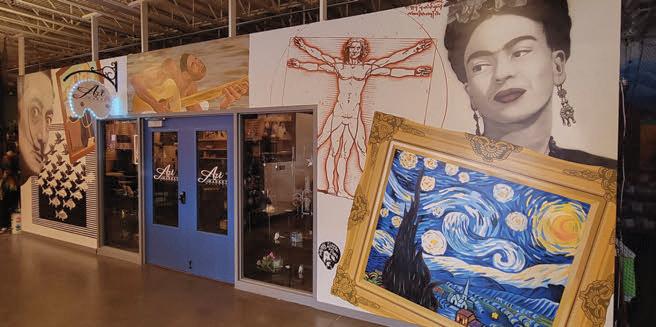
BY PETER HINTERMAN
For 15 years, Steve Wood displayed his exceptional, detailed portraits at Art at the Market. “I was a vendor and artist there since 2006,” he remembers. “In 2009, I became board president and I continued in that position until April of 2021.” His dedication to the gallery was appreciated by his fellow artists. Recently, he left the gallery and his position due to new family and work obligations; but there was one more thing he wanted to do. “I’ve been painting murals for nearly 25 years and when the gallery moved to its new location in the Flint Farmers’ Market, an opportunity presented itself.” A new room for the gallery was built, complete with a blank wall – or to an artist, a canvas. “It was a giant space and I felt it would be a sin to leave it empty,” he explains.
For years, Wood wanted to paint an homage to his favorite artists and he took this chance to make it happen. Welcoming Farmers’ Market patrons to the gallery is a mural featuring eight artists who defined

the medium, either in visage or a representation of their famous works. Art lovers will easily recognize the faces of Frida Kahlo and Salvador Dali, and the art of Vincent Van Gogh, Leonardo Davinci, M. C. Escher, Grant Wood and Ernie Barnes. Tucked away at the bottom of the mural is an image everyone will recognize as the logo of the legendary painter and TV host, Bob Ross. “Ross was an afterthought,” says Wood. “Originally, the plan was to represent just seven artists but when I was finished, I noticed that I had some more space. Someone suggested Ross and I thought he would be the perfect way to finish it.”
Wood has been a part of the gallery for a long time and is honored to be able to leave his mark on the new location. “It’s been a labor of love,” he says. “I started the mural in October of 2021 and finished it this April. I wanted to paint something everyone will appreciate and recognize that attracts people to the gallery.”













